Paul van Yperen's Blog, page 34
October 31, 2024
Anne Vernon
French film and television actress Anne Vernon (1924) appeared in 40 films between 1948 and 1970. She has made films in France, England, Italy, the United States, Germany, Austria, and Spain. She worked with acclaimed directors such as Jacques Becker, Roberto Rossellini and Jacques Demy. After her acting career ended, she returned to the passion of her youth, painting. Anne Vernon is 100.
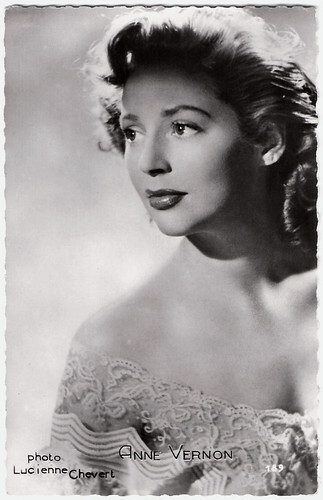
French postcard by Editions P.I., Paris, offered by Les carbones Korès, no. 189. Photo: Lucienne Chevert.
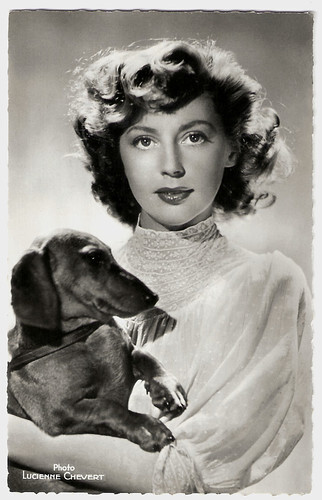
French postcard by Edition du Globe, Paris, no. 137. Photo: Lucienne Chevert.
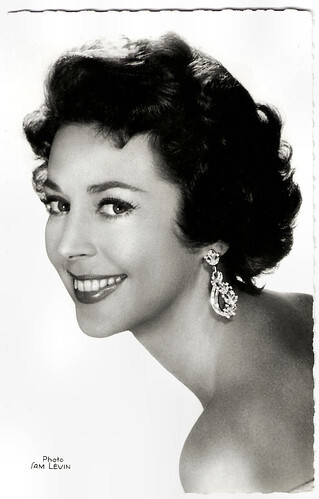
French postcard by Editions du Globe, Paris, no. 667. Photo: Sam Lévin.
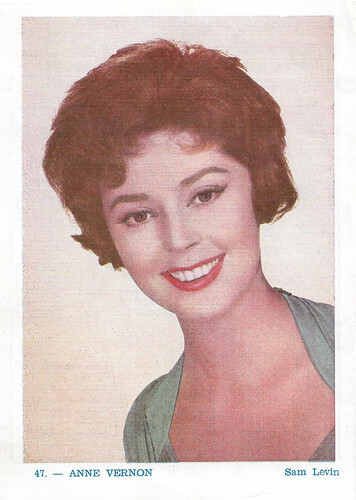
Belgian collector card by Merbotex, Brussels, for Cinema Palace, Izegem, no. 47. Photo: Sam Lévin.
The great revelation of the year
Anne Vernon was born Édith Antoinette Alexandrine Vignaud in 1924 in Saint-Denis, a working-class Paris suburb. Her father, Georges Vernon, was an executive, while her mother, Raymonde, was a seamstress. Édith had a three-and-a-half-year-old older sister, Georgia. Édith attended the Lycée Lamartine in Paris's 9th arrondissement. When she was 14, the family moved to Enghien-les-Bains, which had a higher social status. Convinced of her aptitude for fashion design, the teenager wanted to enrol at the Ecole des Arts Appliqués à l'Industrie in Paris. Her parents approved of this ambition. Edith turned 16 during the Occupation. Independent, she moved to Paris, renting a small flat on Place du Tertre with a friend. She frequented the artists of Saint-Germain-des-Prés and made progress in advertising design and sketching children's dresses.
Her brother-in-law introduced her to the famous couturier Marcel Rochas. She presented him with a design for a bottle for his new perfume, Echec. Rochas liked her. He had created a film department, and assigned Edith to it. She met Madeleine Sologne at a costume fitting for L'éternel retour. The film's producer, André Paulvé, offered her a screen test, for which Marcel Achard gave her a text. She then met Jean Cocteau , who encouraged her to enrol in Tania Balachova's drama classes. Balachova struggled with the premiere of Jean-Paul Sartre's ‘Huis Clos’ at the Théâtre du Vieux-Colombier. Short of an understudy for his play, director Louis Ducreux suggested that Edith take her first step into the theatre. Scared, Edith hesitated but, convinced of the good health of Gaby Sylvia , the lead character, finally accepted. However, Gaby Sylvia fell ill and Edith played the role for four months. Shortly afterwards, the Vieux-Colombier staged André Roussin's play ‘Jean-Baptiste, le mal aimé’ (1944), in which the lead role was also given to Gaby Sylvia . Once again, she had a relapse and Roussin saw only one replacement to take over the role. Edith turned out to be a perfect Armande Béjart opposite André Roussin in Molière's clothes.
In 1946, Fernand Ledoux at the Comédie Française invited the young actress to join his troupe for a year-long tour of South America (1946). The programme included venues in São Paulo, Buenos Aires, and Santiago de Chile. Jean Anouilh soon hired her for his new play ‘L'invitation au château’. Pierre de Hérain, son-in-law of Marshal Pétain, hired Edith for a small role in the crime comedy Le mannequin assassin/The Murdered Model (Pierre de Hérain,1947), It was her film debut. From then on, Edith alternated between theatre and film. British director Donald B. Wilson hired her for a film he was preparing to shoot at Pinewood Studios, the romantic comedy Warning to Wantons (Donald Wilson 1948). The name Edith Vignaud was too difficult to pronounce in Great Britain, so her name became Anne Vernon. The choice was made based on the responses to the competition organised for this purpose. Warning to Wantons, the first film to use the ‘Independent Frame’ television technique on a film set, was a severe financial flop.
At the end of her career, Anne Vernon’s filmography included 40 titles. In great demand, she made films in France, England, Italy, the United States, Germany, Austria and Spain. After her English film, Emile-Edwin Reinert offered her the female lead in Ainsi finit la nuit/Thus Finishes the Night (Emil E. Reinert, 1949). L'Ecran français declared her the great revelation of the year. She played the wife of a public prosecutor (Henri Guisol) who falls in love with one of his former school friends ( Claude Dauphin ), a passion that is intended to have no future. Vernon herself also immediately fell in love with Dauphin who was married to Rosine Deréan . He did not want to hurt his wife who was still scarred by her internment in the Ravensbrück camp. Shortly afterwards, Anne met Robert Badinter, a young lawyer and future Minister of Justice during François Mitterrand's first seven-year term in office. They married in 1957 but divorced eight years later, though they remained the best of friends. Also with Reinert, Anne Vernon appeared in the Paris episode of the anthology film A Tale of Five Cities (Romolo Marcellini, Emil E. Reinert, Wolfgang Staudte, Montgomery Tully, Géza von Cziffra, 1949).
In 1950, after Ralph Habib had directed her in the detective film Rue des saussaies, she finally got her breakthrough in Jacques Becker’s wonderful romance Edouard et Caroline (Jacques Becker, 1950) opposite Daniel Gélin . Two years later, the actress reunited with her director for Rue de l'Estrapade/Françoise Steps Out (Jacques Becker, 1953), a little street in the Latin Quarter near the Panthéon, where, as the deceived wife of the very seductive Louis Jourdan , she valiantly resists the advances of the same Daniel Gélin , a young bohemian musician. Now recognised and acclaimed by the public, she followed this up in London with Time Bomb (Ted Tetzlaff, 1952), as the wife of an American engineer played by Glenn Ford . Capable of tense dramatic roles as well, she made only one Hollywood film during her career, playing the second femme lead in the Film Noir Shakedown (Joseph Pevney, 1950) with Howard Duff and Peggy Dow.
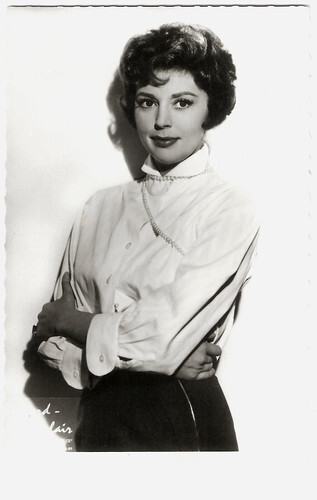
French postcard by Editions P.I., Paris, no. 859. Photo: Studio Bernard et Vauclair.
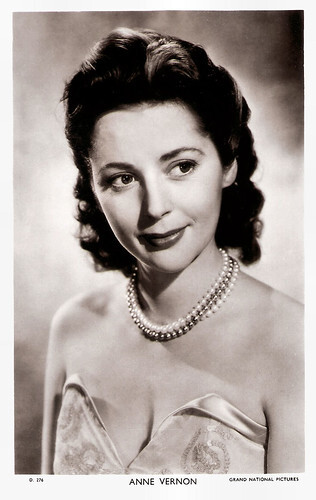
British postcard in the Picturegoer Series, London, no. D 276. Photo: Grand National Pictures. Anne Vernon in A Tale of Five Cities (Emil E. Reinert, a.o., 1951).
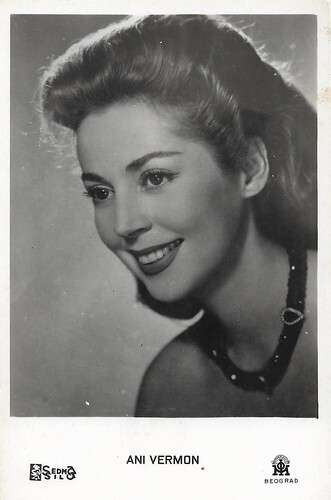
Yugoslavian postcard by Sedma Sila. Photo: Morava Film, Beograd (Belgrade).
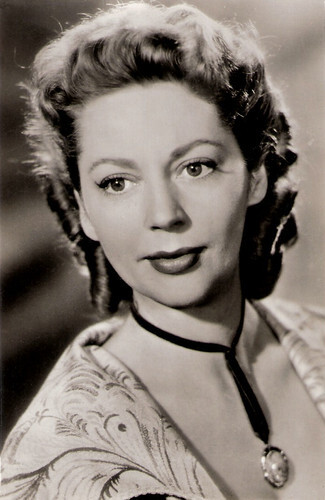
East-German postcard by VEB Progress Film-Vertrieb, Berlin, no. 53/1, 1956. Photo: DEFA / Neufeld. Anne Vernon in Das Fräulein von Scuderi (Eugen York, 1955).
Praise from both François Truffaut and Jean-Luc Godard
Back in Paris, Anne Vernon embarked on a rather eventful honeymoon with François Périer in Jeunes mariés/Newlyweds (Gilles Grangier, 1953). She crossed the Channel again to play in The Love Lottery (Charles Crichton, 1953), with David Niven . She also discovered the pleasant countryside around Lake Como and acquired one of her best souvenirs. In Bel ami (Louis Daquin, 1954), freely adapted from the short story by Guy de Maupassant, she is one of the victims of the impudent Jean Danet, who played the title role.
Other films include the historical crime drama L'affaire des poisons/The Poison Affair (Henri Decoin, 1955), in which she played the innocent but manipulated next-in-line to the Marquise de Montespan ( Danielle Darrieux ), the Italian film La donna più bella del mondo/Beautiful But Dangerous (Robert Z. Leonard, 1955), the romanticised story of singer Lina Cavalieri played by Gina Lollobrigida; Le long des trottoirs/The Width of the Pavement (Léonide Moguy, 1956) about a social worker, who tries to rescue Danik Patisson from prostitution, and Les lavandières du Portugal/The Washerwomen of Portugal (Pierre Gaspard-Huit, Ramón Torrado, 1957). In Il generale Della Rovere/General Dell Rovere (Roberto Rossellini, 1959), winner of the Golden Lion at the Venice Film Festival, she begs for help from the superb forger Vittorio De Sica , Her small role earned her praise from both François Truffaut and Jean-Luc Godard .
In 1963, Anne Vernon appeared as Catherine Deneuve ’s mother in Les parapluies de Cherbourg/The Umbrellas of Cherbourg (Jacques Demy, 1963). Jacques Demy, who had noticed and appreciated her in Becker's films, offered Anne Vernon the singing role (dubbed by Christiane Legrand, composer Michel Legrand's sister) of the owner of the umbrella shop she runs with her daughter, Catherine Deneuve . A director with an elegant and precise style, Demy demonstrates in this musical an art of mise-en-scène brought to perfection. The film won the Palme d'Or at the Cannes Film Festival and became a hit with audiences. Vernon followed this up with Marcel Achard's Patate/Friend of the Family (Robert Thomas, 1964), in which she reunited with Danielle Darrieux and Jean Marais .
René Gainville, who had recently become her second husband, directed her in the crime films L'homme de Mykonos/The Man from Mykonos (René Gainville, 1965) with Gabriele Tinti and Le démoniaque/The Woman Is a Stranger (René Gainville,1966). The latter film, adapted from a novel by James Hadley Chase by Jean-Louis Curtis, cast her as the mother-in-law of a neuropathic murderer. Hadley Chase later said that this was the only film adaptation of his work of which he felt proud. She spent two days on the set of Radley Metzger's lesbian soft-core Therese and Isabelle (Radley Metzger, 1967), based on the novel by Violette Leduc. This was Anne Vernon's final film appearance. She made several notable appearances in the theatre, including in ‘Tartuffe’ by Molière. In 1971, she embarked on a tour of French-speaking countries with ‘Quatre pièces sur jardin’, a lively comedy written by Barillet and Grédy, in which she played four roles. After her theatrical career stopped, Vernon’s relationship with René Gainville also came to an end.
In 1972, she made a final appearance on television in a long-forgotten mini-series, Pont dormant (Fernand Marzelle, 1972). Edith Vignaud returned to her great passion, painting. Jean-Marie Drot, a television director and producer, was one of the first to encourage her to exhibit, which she did with great success in Paris, Saint-Tropez and New York. She signed her works with 3 mysterious letters, FMR (to be read phonetically). In 1988, she remarried Jean-Pierre Prouteau, Secretary of State for Small and Medium-sized Industry under Valéry Giscard d'Estaing. He had been her partner for several years. He died in autumn 1998. Yvan Foucart at L’encinémathèque: "Although she declares that she never had the ‘sacred fire’ to succeed in the cinema, she is certain that she could not do without painting. She has no worries about being away from the stage, even if she is surprised and delighted by the interest she arouses among film fans, as shown by the volume of mail she continues to receive." After the death of Micheline Presle in 2024, Anne Vernon is now the Doyenne of the French cinema.
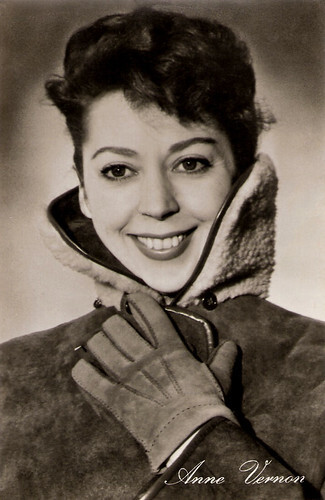
East-German postcard by VEB Progress Film-Vertrieb, Berlin, no. 389, 1957. Photo: Peter Steffen.
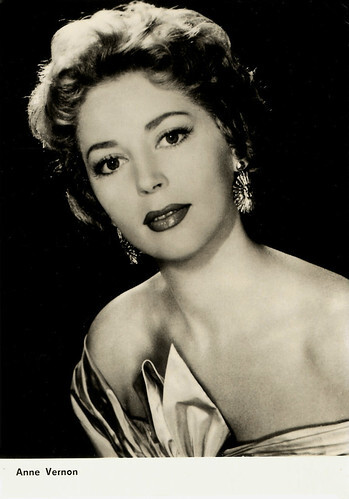
East-German postcard by VEB Progress Film-Vertrieb, Berlin, no. 2434, 1965.
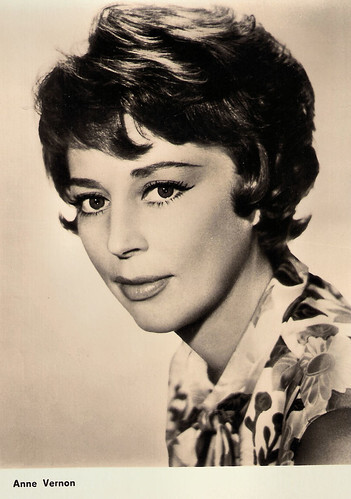
East-German postcard by VEB Progress Film-Vertrieb, Berlin, no. 2720, 1966.
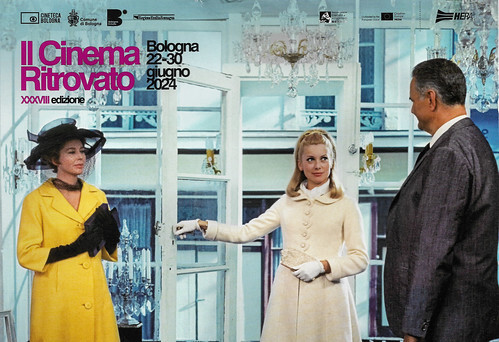
Italian card by Cineteca Bologna to promote Il Cinema Ritrovato 2024. Photo: Anne Vernon, Catherine Deneuve and Harald Wolff in Les parapluies de Cherbourg/The Umbrellas of Cherbourg (Jacques Demy, 1963).
Sources: Sources: Yvan Foucart (Les Gens du Cinéma – French), (IMDb), Wikipedia (English, German and French), and .

French postcard by Editions P.I., Paris, offered by Les carbones Korès, no. 189. Photo: Lucienne Chevert.

French postcard by Edition du Globe, Paris, no. 137. Photo: Lucienne Chevert.

French postcard by Editions du Globe, Paris, no. 667. Photo: Sam Lévin.

Belgian collector card by Merbotex, Brussels, for Cinema Palace, Izegem, no. 47. Photo: Sam Lévin.
The great revelation of the year
Anne Vernon was born Édith Antoinette Alexandrine Vignaud in 1924 in Saint-Denis, a working-class Paris suburb. Her father, Georges Vernon, was an executive, while her mother, Raymonde, was a seamstress. Édith had a three-and-a-half-year-old older sister, Georgia. Édith attended the Lycée Lamartine in Paris's 9th arrondissement. When she was 14, the family moved to Enghien-les-Bains, which had a higher social status. Convinced of her aptitude for fashion design, the teenager wanted to enrol at the Ecole des Arts Appliqués à l'Industrie in Paris. Her parents approved of this ambition. Edith turned 16 during the Occupation. Independent, she moved to Paris, renting a small flat on Place du Tertre with a friend. She frequented the artists of Saint-Germain-des-Prés and made progress in advertising design and sketching children's dresses.
Her brother-in-law introduced her to the famous couturier Marcel Rochas. She presented him with a design for a bottle for his new perfume, Echec. Rochas liked her. He had created a film department, and assigned Edith to it. She met Madeleine Sologne at a costume fitting for L'éternel retour. The film's producer, André Paulvé, offered her a screen test, for which Marcel Achard gave her a text. She then met Jean Cocteau , who encouraged her to enrol in Tania Balachova's drama classes. Balachova struggled with the premiere of Jean-Paul Sartre's ‘Huis Clos’ at the Théâtre du Vieux-Colombier. Short of an understudy for his play, director Louis Ducreux suggested that Edith take her first step into the theatre. Scared, Edith hesitated but, convinced of the good health of Gaby Sylvia , the lead character, finally accepted. However, Gaby Sylvia fell ill and Edith played the role for four months. Shortly afterwards, the Vieux-Colombier staged André Roussin's play ‘Jean-Baptiste, le mal aimé’ (1944), in which the lead role was also given to Gaby Sylvia . Once again, she had a relapse and Roussin saw only one replacement to take over the role. Edith turned out to be a perfect Armande Béjart opposite André Roussin in Molière's clothes.
In 1946, Fernand Ledoux at the Comédie Française invited the young actress to join his troupe for a year-long tour of South America (1946). The programme included venues in São Paulo, Buenos Aires, and Santiago de Chile. Jean Anouilh soon hired her for his new play ‘L'invitation au château’. Pierre de Hérain, son-in-law of Marshal Pétain, hired Edith for a small role in the crime comedy Le mannequin assassin/The Murdered Model (Pierre de Hérain,1947), It was her film debut. From then on, Edith alternated between theatre and film. British director Donald B. Wilson hired her for a film he was preparing to shoot at Pinewood Studios, the romantic comedy Warning to Wantons (Donald Wilson 1948). The name Edith Vignaud was too difficult to pronounce in Great Britain, so her name became Anne Vernon. The choice was made based on the responses to the competition organised for this purpose. Warning to Wantons, the first film to use the ‘Independent Frame’ television technique on a film set, was a severe financial flop.
At the end of her career, Anne Vernon’s filmography included 40 titles. In great demand, she made films in France, England, Italy, the United States, Germany, Austria and Spain. After her English film, Emile-Edwin Reinert offered her the female lead in Ainsi finit la nuit/Thus Finishes the Night (Emil E. Reinert, 1949). L'Ecran français declared her the great revelation of the year. She played the wife of a public prosecutor (Henri Guisol) who falls in love with one of his former school friends ( Claude Dauphin ), a passion that is intended to have no future. Vernon herself also immediately fell in love with Dauphin who was married to Rosine Deréan . He did not want to hurt his wife who was still scarred by her internment in the Ravensbrück camp. Shortly afterwards, Anne met Robert Badinter, a young lawyer and future Minister of Justice during François Mitterrand's first seven-year term in office. They married in 1957 but divorced eight years later, though they remained the best of friends. Also with Reinert, Anne Vernon appeared in the Paris episode of the anthology film A Tale of Five Cities (Romolo Marcellini, Emil E. Reinert, Wolfgang Staudte, Montgomery Tully, Géza von Cziffra, 1949).
In 1950, after Ralph Habib had directed her in the detective film Rue des saussaies, she finally got her breakthrough in Jacques Becker’s wonderful romance Edouard et Caroline (Jacques Becker, 1950) opposite Daniel Gélin . Two years later, the actress reunited with her director for Rue de l'Estrapade/Françoise Steps Out (Jacques Becker, 1953), a little street in the Latin Quarter near the Panthéon, where, as the deceived wife of the very seductive Louis Jourdan , she valiantly resists the advances of the same Daniel Gélin , a young bohemian musician. Now recognised and acclaimed by the public, she followed this up in London with Time Bomb (Ted Tetzlaff, 1952), as the wife of an American engineer played by Glenn Ford . Capable of tense dramatic roles as well, she made only one Hollywood film during her career, playing the second femme lead in the Film Noir Shakedown (Joseph Pevney, 1950) with Howard Duff and Peggy Dow.

French postcard by Editions P.I., Paris, no. 859. Photo: Studio Bernard et Vauclair.

British postcard in the Picturegoer Series, London, no. D 276. Photo: Grand National Pictures. Anne Vernon in A Tale of Five Cities (Emil E. Reinert, a.o., 1951).

Yugoslavian postcard by Sedma Sila. Photo: Morava Film, Beograd (Belgrade).

East-German postcard by VEB Progress Film-Vertrieb, Berlin, no. 53/1, 1956. Photo: DEFA / Neufeld. Anne Vernon in Das Fräulein von Scuderi (Eugen York, 1955).
Praise from both François Truffaut and Jean-Luc Godard
Back in Paris, Anne Vernon embarked on a rather eventful honeymoon with François Périer in Jeunes mariés/Newlyweds (Gilles Grangier, 1953). She crossed the Channel again to play in The Love Lottery (Charles Crichton, 1953), with David Niven . She also discovered the pleasant countryside around Lake Como and acquired one of her best souvenirs. In Bel ami (Louis Daquin, 1954), freely adapted from the short story by Guy de Maupassant, she is one of the victims of the impudent Jean Danet, who played the title role.
Other films include the historical crime drama L'affaire des poisons/The Poison Affair (Henri Decoin, 1955), in which she played the innocent but manipulated next-in-line to the Marquise de Montespan ( Danielle Darrieux ), the Italian film La donna più bella del mondo/Beautiful But Dangerous (Robert Z. Leonard, 1955), the romanticised story of singer Lina Cavalieri played by Gina Lollobrigida; Le long des trottoirs/The Width of the Pavement (Léonide Moguy, 1956) about a social worker, who tries to rescue Danik Patisson from prostitution, and Les lavandières du Portugal/The Washerwomen of Portugal (Pierre Gaspard-Huit, Ramón Torrado, 1957). In Il generale Della Rovere/General Dell Rovere (Roberto Rossellini, 1959), winner of the Golden Lion at the Venice Film Festival, she begs for help from the superb forger Vittorio De Sica , Her small role earned her praise from both François Truffaut and Jean-Luc Godard .
In 1963, Anne Vernon appeared as Catherine Deneuve ’s mother in Les parapluies de Cherbourg/The Umbrellas of Cherbourg (Jacques Demy, 1963). Jacques Demy, who had noticed and appreciated her in Becker's films, offered Anne Vernon the singing role (dubbed by Christiane Legrand, composer Michel Legrand's sister) of the owner of the umbrella shop she runs with her daughter, Catherine Deneuve . A director with an elegant and precise style, Demy demonstrates in this musical an art of mise-en-scène brought to perfection. The film won the Palme d'Or at the Cannes Film Festival and became a hit with audiences. Vernon followed this up with Marcel Achard's Patate/Friend of the Family (Robert Thomas, 1964), in which she reunited with Danielle Darrieux and Jean Marais .
René Gainville, who had recently become her second husband, directed her in the crime films L'homme de Mykonos/The Man from Mykonos (René Gainville, 1965) with Gabriele Tinti and Le démoniaque/The Woman Is a Stranger (René Gainville,1966). The latter film, adapted from a novel by James Hadley Chase by Jean-Louis Curtis, cast her as the mother-in-law of a neuropathic murderer. Hadley Chase later said that this was the only film adaptation of his work of which he felt proud. She spent two days on the set of Radley Metzger's lesbian soft-core Therese and Isabelle (Radley Metzger, 1967), based on the novel by Violette Leduc. This was Anne Vernon's final film appearance. She made several notable appearances in the theatre, including in ‘Tartuffe’ by Molière. In 1971, she embarked on a tour of French-speaking countries with ‘Quatre pièces sur jardin’, a lively comedy written by Barillet and Grédy, in which she played four roles. After her theatrical career stopped, Vernon’s relationship with René Gainville also came to an end.
In 1972, she made a final appearance on television in a long-forgotten mini-series, Pont dormant (Fernand Marzelle, 1972). Edith Vignaud returned to her great passion, painting. Jean-Marie Drot, a television director and producer, was one of the first to encourage her to exhibit, which she did with great success in Paris, Saint-Tropez and New York. She signed her works with 3 mysterious letters, FMR (to be read phonetically). In 1988, she remarried Jean-Pierre Prouteau, Secretary of State for Small and Medium-sized Industry under Valéry Giscard d'Estaing. He had been her partner for several years. He died in autumn 1998. Yvan Foucart at L’encinémathèque: "Although she declares that she never had the ‘sacred fire’ to succeed in the cinema, she is certain that she could not do without painting. She has no worries about being away from the stage, even if she is surprised and delighted by the interest she arouses among film fans, as shown by the volume of mail she continues to receive." After the death of Micheline Presle in 2024, Anne Vernon is now the Doyenne of the French cinema.

East-German postcard by VEB Progress Film-Vertrieb, Berlin, no. 389, 1957. Photo: Peter Steffen.

East-German postcard by VEB Progress Film-Vertrieb, Berlin, no. 2434, 1965.

East-German postcard by VEB Progress Film-Vertrieb, Berlin, no. 2720, 1966.

Italian card by Cineteca Bologna to promote Il Cinema Ritrovato 2024. Photo: Anne Vernon, Catherine Deneuve and Harald Wolff in Les parapluies de Cherbourg/The Umbrellas of Cherbourg (Jacques Demy, 1963).
Sources: Sources: Yvan Foucart (Les Gens du Cinéma – French), (IMDb), Wikipedia (English, German and French), and .
Published on October 31, 2024 23:00
October 30, 2024
Gustav von Wangenheim
Gustav von Wangenheim (1895-1975), was a German actor and director. He is mainly remembered for his role as Thomas Hutter in F.W. Murnau's silent masterpiece Nosferatu (1922). He also had major parts in Romeo und Julia im Schnee (1920), Kohlhiesels Töchter (1920) both by Ernst Lubitsch, and Frau im Mond (1929) by Fritz Lang.
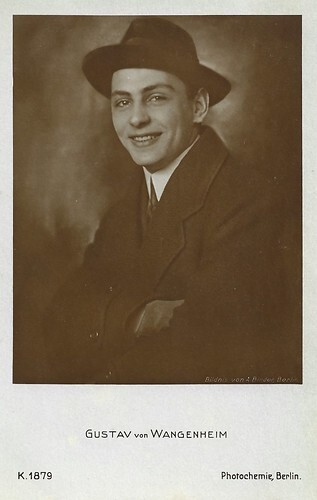
German postcard by Photochemie, Berlin, no. K. 1879. Photo: Alex Binder.
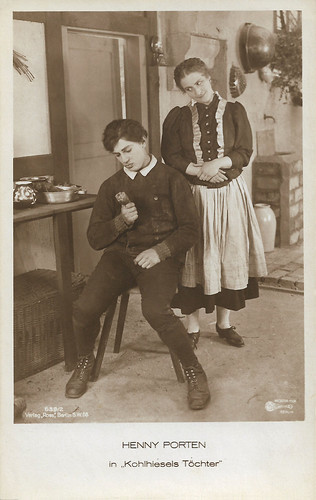
German postcard by Ross Verlag no. 630/2. Photo: Messter Film, Berlin. Henny Porten and Gustav von Wangenheim in Kohlhiesels Töchter/Kohlhiesel's Daughters (Ernst Lubitsch, 1920).
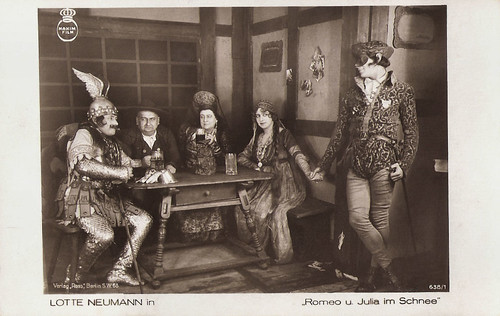
German postcard by Ross Verlag, no. 636/1. Photo: Maxim Film. Jakob Tiedtke (Herr Capulethofer), Marga Köhler (his wife), Lotte Neumann (their daughter Julia) and Gustav von Wangenheim (Romeo Montekugerl) in the comedy Romeo und Julia im Schnee/Romeo and Juliet in the Snow (Ernst Lubitsch, 1920). The man on the left dressed as an antique hero could be Julius Falkenstein as Paris.
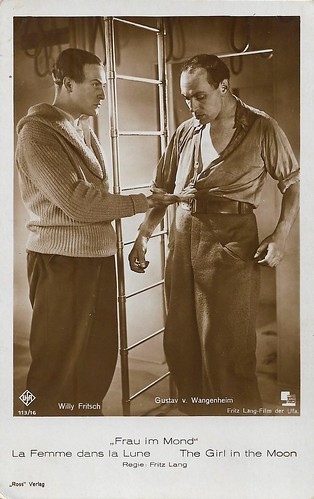
German postcard by Ross Verlag, Berlin, no. 113/16. Photo: Fritz Lang-Film der UFA. Photo: Ufa. Willy Fritsch and Gustav von Wangenheim in Frau im Mond/Girl in the Moon (Fritz Lang, 1929).
His most enduring role
Gustav von Wangenheim was born Ingo Clemens Gustav Adolf Freiherr von Wangenheim in Wiesbaden, Hesse, in 1895. His parents were Eduard Clemens Freiherr von Wangenheim and the Jewish actress Minna Mengers. Both of his parents were performers. His father, who used the stage name Eduard von Winterstein , appeared in over 200 films between 1910 and 1960. After his mother committed suicide when Gustav von Wangenheim was only four years old, his father married the actress Hedwig Pauly, who was also Jewish.
Gustav attended Max Reinhardt 's drama school in 1912. This was followed by stage engagements in Vienna, Darmstadt and Berlin. He briefly served in the Imperial German Army during World War I but was discharged in 1915 because of an eye injury. Von Wangenheim made his screen debut in Passionels Tagebuch/Passionel's Diary (Louis Ralph, 1914) and appeared in the silent Science Fiction serial Homunculus (Otto Rippert, 1916) written by Robert Reinert. Fritz Lang was one of Rippert's assistants during filming. Von Wangenheim co-starred in Ernst Lubitsch 's classic silent comedies Kohlhiesels Töchter/Kohlhiesel's Daughters (Ernst Lubitsch, 1920) starring Henny Porten and Emil Jannings , and the William Shakespeare variation Romeo und Julia im Schnee/Romeo and Juliet in the Snow (Ernst Lubitsch, 1920) with Lotte Neumann .
In 1921, Von Wangenheim was cast in F. W. Murnau 's expressionist vampire film Nosferatu/Nosferatu: A Symphony of Horror as Thomas Hutter which would prove to be his most enduring role. Max Schreck starred as Count Orlok, a vampire who preys on the wife (Greta Schröder) of his estate agent Thomas Hutter and brings the plague to their town. Nosferatu was an unauthorised and unofficial adaptation of the 1897 novel 'Dracula'. Hutter was based on the character of Jonathan Harker in 'Dracula'. Various other names and details were changed. Count Dracula was renamed Count Orlok then finally Nosferatu, an archaic Romanian word with a suggested etymology of Nesuferitu`, meaning "the offensive one" or "the insufferable one".
Among Gustav von Wangenheim's other silent filmnworks were the Science Fiction films Das Haus zum Mond/The House on the Moon (Karl Heinz Martin, 1921) starring Leontine Kühnberg , the expressionist film Schatten – Eine nächtliche Halluzination/Warning Shadows (Arthur Robison, 1923) starring Fritz Kortner and Ruth Weyher and Fritz Lang 's Frau im Mond/Girl in the Moon (Fritz Lang, 1929) starring Willy Fritsch and Gerda Maurus .
In 1917, Von Wangenheim wrote a play about the October Revolution, 'Der Mann Fjodor', for which he received a prize from 'the magazine 'Junges Deutschland' (Young Germany). Paul Cassirer became his publisher. He came into contact with cultural politicians from the USPD (Independent Social Democratic Party of Germany) and in November 1918 he joined the Reichstag and the 'Council of Intellectual Workers'. Since 1922, he was a member of the Communist Party of Germany (the KPD). Gustav von Wangenheim married fellow communist Inge Franke in 1931. They founded the Communist theatre company Die Truppe '31. Die Truppe '31 produced three plays, authored and directed by Von Wangenheim before it was shut down by order of the Nazi regime in 1933.

German postcard. Ross Verlag, no. 638/2. Photo: Maxim Film. Publicity still for Romeo und Julia im Schnee/Romeo and Juliet in the Snow (Ernst Lubitsch, 1920), with Lotte Neumann (Julia Capulethofer) and Gustav von Wangenheim (Romeo Montekugerl). Behind them, Jakob Tiedtke and Marga Köhler as Julia's parents.
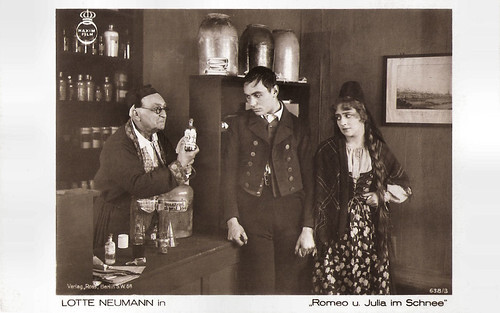
German postcard by Ross Verlag, no. 638/3. Photo: Maxim Film. Lotte Neumann (Julia) and Gustav von Wangenheim (Romeo Montekugerl) in Romeo und Julia im Schnee/Romeo and Juliet in the Snow (Ernst Lubitsch, 1920).
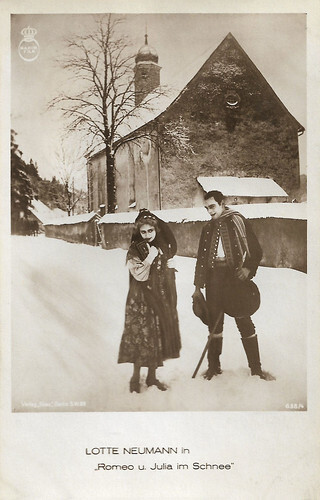
German postcard by Ross Verlag, no. 636/4. Photo: Maxim Film. Lotte Neumann (Julia) and Gustav von Wangenheim (Romeo Montekugerl) in Romeo und Julia im Schnee/Romeo and Juliet in the Snow (Ernst Lubitsch, 1920).
Arrested in the Soviet Union
Gustav von Wangenheim and his wife Inge fled Nazi Germany in 1933. They first moved to Paris, but then found refuge in the Soviet Union. While living in exile at Moscow's Hotel Lux, he continued writing and producing films, such as Der Kampfer/The Fighter (Gustav von Wangenheim, 1936), about the Reichstag fire trial and communist leader Georgi Dimitroff. The film was banned by Stalin shortly after its completion, and countless contributors were arrested and shot. Von Wangenheim was also the head of the German language Cabaret Kolonne Links.
In 1936, during the Stalinist purges, Gustav von Wangenheim denounced his colleagues Carola Neher and her husband Anatol Becker as Trotskyites. Becker was executed and Neher died in the Gulag system after five years in prison. Gustav von Wangenheim's son later stated the accusations that his father denounced Neher and Becker were one-sided and inaccurate. His son claimed his father, after being arrested by the NKVD and a lengthy interrogation, signed a statement that implicated Carola Neher as being 'anti-soviet' but had in fact explicitly refuted the accusation that Neher and Anatol Becker had planned to murder Stalin. After the National Socialists sentenced Von Wangenheim to death in absentia, he finally accepted Soviet citizenship in 1940. When the war broke out, he began working for the 7th Political Department of the Red Army.
After World War II, Von Wangenheim returned to East Germany. For a few months from September 1945, he was director of the Deutsches Theater Berlin, which he reopened. His first productions, such as 'Nathan der Weise' (Nathan the Wise), 'Hamlet' and 'Gerichtstag' (Judgement Day), were celebrated by the Berlin public. Von Wangenheim had resumed the great tradition of Max Reinhardt . At the same time, the members of the ensemble and the theatre director fought for the release of Gustaf Gründgens from the internment camp in Jamlitz. Gründgens was accused of having cooperated with the National Socialists. Von Wangenheim, but also Ernst Busch and other artists, campaigned for Gründgens' political rehabilitation. Gründgens returned to Berlin on 9 March 1946 and became an actor at the Deutsches Theater again.
On 29 May 1946, a Soviet play was performed for the first time at the Deutsches Theater, 'Stürmischer Lebensabend' by Leonid Rachmanow. It was a defeat for the Soviet military administration and Gustav von Wangenheim was relieved of his duties as theatre director. Throughout his life, he never understood why he was dismissed. While von Wangenheim's appearances in films became rare in the post-war years, he continued to work as a director and screenwriter for DEFA. His films included Und wieder 48/48 All Over Again! (Gustav von Wangenheim, 1948) with a role for his father, Eduard von Winterstein , and Gefährliche Fracht/Dangerous Cargo (Gustav von Wangenheim, 1954).
Gustav von Wangenheim was awarded the National Prize of the GDR for his artistic work, especially for his play 'Du bist der Richtige' (You Are the Right One), which he wrote for the opening of the newly founded Theatre of Friendship. He was married to Inge von Wangenheim from 1931 to 1954. The couple had two sons, Friedel and Edi, and twin daughters, Elisabeth and Eleonora von Wangenheim. Von Wangenheim died in East Berlin in 1975 and was buried in the Friedrichsfelde cemetery in Berlin. He was 80.
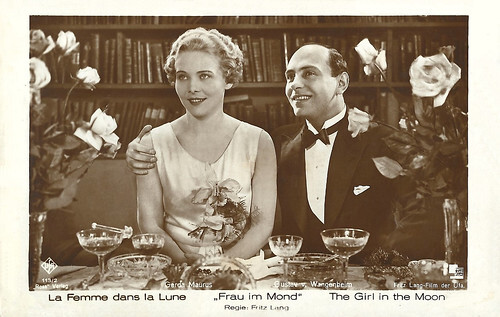
German postcard by Ross Verlag, Berlin, no. 113/2. Photo: Fritz Lang-Film der Ufa. Gerda Maurus and Gustav von Wangenheim in Frau im Mond/Girl in the Moon (Fritz Lang, 1929).
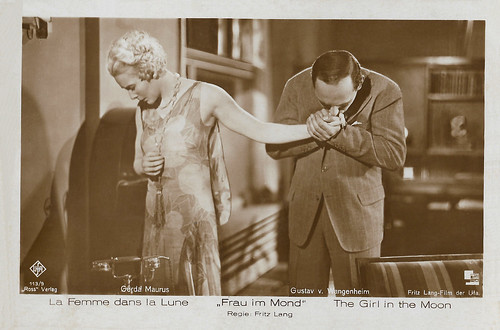
German postcard by Ross Verlag, no. 113/9. Photo: Ufa. Gerda Maurus and Gustav von Wangenheim in Frau im Mond/Girl in the Moon (Fritz Lang, 1929).
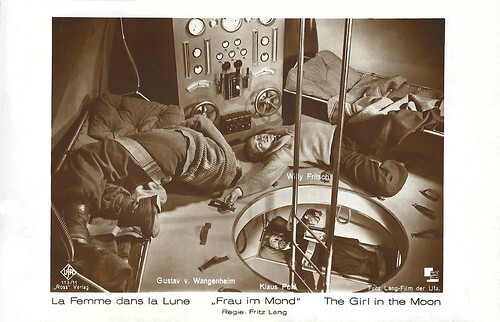
German postcard. Ross Verlag, Berlin, no. 113/11. Photo: Fritz Lang-Film der Ufa. Willy Fritsch , Klaus Pohl, and Gustav von Wangenheim in Frau im Mond/Girl in the Moon (Fritz Lang, 1929).
Sources: (IMDb), Lea S. (Silent-ology), Wikipedia (German and English) and .

German postcard by Photochemie, Berlin, no. K. 1879. Photo: Alex Binder.

German postcard by Ross Verlag no. 630/2. Photo: Messter Film, Berlin. Henny Porten and Gustav von Wangenheim in Kohlhiesels Töchter/Kohlhiesel's Daughters (Ernst Lubitsch, 1920).

German postcard by Ross Verlag, no. 636/1. Photo: Maxim Film. Jakob Tiedtke (Herr Capulethofer), Marga Köhler (his wife), Lotte Neumann (their daughter Julia) and Gustav von Wangenheim (Romeo Montekugerl) in the comedy Romeo und Julia im Schnee/Romeo and Juliet in the Snow (Ernst Lubitsch, 1920). The man on the left dressed as an antique hero could be Julius Falkenstein as Paris.

German postcard by Ross Verlag, Berlin, no. 113/16. Photo: Fritz Lang-Film der UFA. Photo: Ufa. Willy Fritsch and Gustav von Wangenheim in Frau im Mond/Girl in the Moon (Fritz Lang, 1929).
His most enduring role
Gustav von Wangenheim was born Ingo Clemens Gustav Adolf Freiherr von Wangenheim in Wiesbaden, Hesse, in 1895. His parents were Eduard Clemens Freiherr von Wangenheim and the Jewish actress Minna Mengers. Both of his parents were performers. His father, who used the stage name Eduard von Winterstein , appeared in over 200 films between 1910 and 1960. After his mother committed suicide when Gustav von Wangenheim was only four years old, his father married the actress Hedwig Pauly, who was also Jewish.
Gustav attended Max Reinhardt 's drama school in 1912. This was followed by stage engagements in Vienna, Darmstadt and Berlin. He briefly served in the Imperial German Army during World War I but was discharged in 1915 because of an eye injury. Von Wangenheim made his screen debut in Passionels Tagebuch/Passionel's Diary (Louis Ralph, 1914) and appeared in the silent Science Fiction serial Homunculus (Otto Rippert, 1916) written by Robert Reinert. Fritz Lang was one of Rippert's assistants during filming. Von Wangenheim co-starred in Ernst Lubitsch 's classic silent comedies Kohlhiesels Töchter/Kohlhiesel's Daughters (Ernst Lubitsch, 1920) starring Henny Porten and Emil Jannings , and the William Shakespeare variation Romeo und Julia im Schnee/Romeo and Juliet in the Snow (Ernst Lubitsch, 1920) with Lotte Neumann .
In 1921, Von Wangenheim was cast in F. W. Murnau 's expressionist vampire film Nosferatu/Nosferatu: A Symphony of Horror as Thomas Hutter which would prove to be his most enduring role. Max Schreck starred as Count Orlok, a vampire who preys on the wife (Greta Schröder) of his estate agent Thomas Hutter and brings the plague to their town. Nosferatu was an unauthorised and unofficial adaptation of the 1897 novel 'Dracula'. Hutter was based on the character of Jonathan Harker in 'Dracula'. Various other names and details were changed. Count Dracula was renamed Count Orlok then finally Nosferatu, an archaic Romanian word with a suggested etymology of Nesuferitu`, meaning "the offensive one" or "the insufferable one".
Among Gustav von Wangenheim's other silent filmnworks were the Science Fiction films Das Haus zum Mond/The House on the Moon (Karl Heinz Martin, 1921) starring Leontine Kühnberg , the expressionist film Schatten – Eine nächtliche Halluzination/Warning Shadows (Arthur Robison, 1923) starring Fritz Kortner and Ruth Weyher and Fritz Lang 's Frau im Mond/Girl in the Moon (Fritz Lang, 1929) starring Willy Fritsch and Gerda Maurus .
In 1917, Von Wangenheim wrote a play about the October Revolution, 'Der Mann Fjodor', for which he received a prize from 'the magazine 'Junges Deutschland' (Young Germany). Paul Cassirer became his publisher. He came into contact with cultural politicians from the USPD (Independent Social Democratic Party of Germany) and in November 1918 he joined the Reichstag and the 'Council of Intellectual Workers'. Since 1922, he was a member of the Communist Party of Germany (the KPD). Gustav von Wangenheim married fellow communist Inge Franke in 1931. They founded the Communist theatre company Die Truppe '31. Die Truppe '31 produced three plays, authored and directed by Von Wangenheim before it was shut down by order of the Nazi regime in 1933.

German postcard. Ross Verlag, no. 638/2. Photo: Maxim Film. Publicity still for Romeo und Julia im Schnee/Romeo and Juliet in the Snow (Ernst Lubitsch, 1920), with Lotte Neumann (Julia Capulethofer) and Gustav von Wangenheim (Romeo Montekugerl). Behind them, Jakob Tiedtke and Marga Köhler as Julia's parents.

German postcard by Ross Verlag, no. 638/3. Photo: Maxim Film. Lotte Neumann (Julia) and Gustav von Wangenheim (Romeo Montekugerl) in Romeo und Julia im Schnee/Romeo and Juliet in the Snow (Ernst Lubitsch, 1920).

German postcard by Ross Verlag, no. 636/4. Photo: Maxim Film. Lotte Neumann (Julia) and Gustav von Wangenheim (Romeo Montekugerl) in Romeo und Julia im Schnee/Romeo and Juliet in the Snow (Ernst Lubitsch, 1920).
Arrested in the Soviet Union
Gustav von Wangenheim and his wife Inge fled Nazi Germany in 1933. They first moved to Paris, but then found refuge in the Soviet Union. While living in exile at Moscow's Hotel Lux, he continued writing and producing films, such as Der Kampfer/The Fighter (Gustav von Wangenheim, 1936), about the Reichstag fire trial and communist leader Georgi Dimitroff. The film was banned by Stalin shortly after its completion, and countless contributors were arrested and shot. Von Wangenheim was also the head of the German language Cabaret Kolonne Links.
In 1936, during the Stalinist purges, Gustav von Wangenheim denounced his colleagues Carola Neher and her husband Anatol Becker as Trotskyites. Becker was executed and Neher died in the Gulag system after five years in prison. Gustav von Wangenheim's son later stated the accusations that his father denounced Neher and Becker were one-sided and inaccurate. His son claimed his father, after being arrested by the NKVD and a lengthy interrogation, signed a statement that implicated Carola Neher as being 'anti-soviet' but had in fact explicitly refuted the accusation that Neher and Anatol Becker had planned to murder Stalin. After the National Socialists sentenced Von Wangenheim to death in absentia, he finally accepted Soviet citizenship in 1940. When the war broke out, he began working for the 7th Political Department of the Red Army.
After World War II, Von Wangenheim returned to East Germany. For a few months from September 1945, he was director of the Deutsches Theater Berlin, which he reopened. His first productions, such as 'Nathan der Weise' (Nathan the Wise), 'Hamlet' and 'Gerichtstag' (Judgement Day), were celebrated by the Berlin public. Von Wangenheim had resumed the great tradition of Max Reinhardt . At the same time, the members of the ensemble and the theatre director fought for the release of Gustaf Gründgens from the internment camp in Jamlitz. Gründgens was accused of having cooperated with the National Socialists. Von Wangenheim, but also Ernst Busch and other artists, campaigned for Gründgens' political rehabilitation. Gründgens returned to Berlin on 9 March 1946 and became an actor at the Deutsches Theater again.
On 29 May 1946, a Soviet play was performed for the first time at the Deutsches Theater, 'Stürmischer Lebensabend' by Leonid Rachmanow. It was a defeat for the Soviet military administration and Gustav von Wangenheim was relieved of his duties as theatre director. Throughout his life, he never understood why he was dismissed. While von Wangenheim's appearances in films became rare in the post-war years, he continued to work as a director and screenwriter for DEFA. His films included Und wieder 48/48 All Over Again! (Gustav von Wangenheim, 1948) with a role for his father, Eduard von Winterstein , and Gefährliche Fracht/Dangerous Cargo (Gustav von Wangenheim, 1954).
Gustav von Wangenheim was awarded the National Prize of the GDR for his artistic work, especially for his play 'Du bist der Richtige' (You Are the Right One), which he wrote for the opening of the newly founded Theatre of Friendship. He was married to Inge von Wangenheim from 1931 to 1954. The couple had two sons, Friedel and Edi, and twin daughters, Elisabeth and Eleonora von Wangenheim. Von Wangenheim died in East Berlin in 1975 and was buried in the Friedrichsfelde cemetery in Berlin. He was 80.

German postcard by Ross Verlag, Berlin, no. 113/2. Photo: Fritz Lang-Film der Ufa. Gerda Maurus and Gustav von Wangenheim in Frau im Mond/Girl in the Moon (Fritz Lang, 1929).

German postcard by Ross Verlag, no. 113/9. Photo: Ufa. Gerda Maurus and Gustav von Wangenheim in Frau im Mond/Girl in the Moon (Fritz Lang, 1929).

German postcard. Ross Verlag, Berlin, no. 113/11. Photo: Fritz Lang-Film der Ufa. Willy Fritsch , Klaus Pohl, and Gustav von Wangenheim in Frau im Mond/Girl in the Moon (Fritz Lang, 1929).
Sources: (IMDb), Lea S. (Silent-ology), Wikipedia (German and English) and .
Published on October 30, 2024 23:00
October 29, 2024
Ross Verlag, Part 8: Ross Verlag in Colour
One of the earliest series by Ross Verlag - or Verlag "Ross" as then still was written on the postcards - is Series 2001: twelve postcards with colour portraits printed on a white paper. The material used is heavier than the regular postcards. The series, published in 1919, features seven actresses and one actor of the German silent cinema. The card numbers are printed on the back of the cards. All the portraits in this series have also been used for sepia-tinted cards by Ross Verlag or by its predecessor Rotophot in the Film Sterne series.
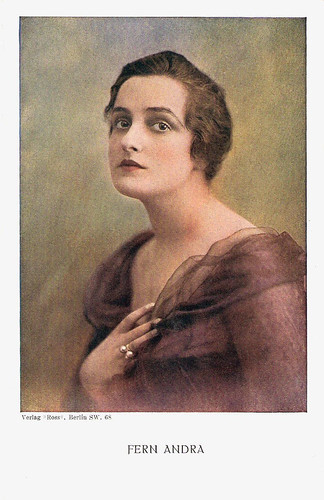
German postcard by Ross Verlag, Berlin, no. 2001/1. Photo: Fern Andra Atelier. See also: Film Sterne, no. 151/3.
'Modern' American actress Fern Andra (1893-1974) became one of the most popular film stars of the German cinema in the 1910s and early 1920s. In her films she mastered tightrope, riding a horse without a saddle, driving cars and motorcycles, bobsleighing, and even boxing.
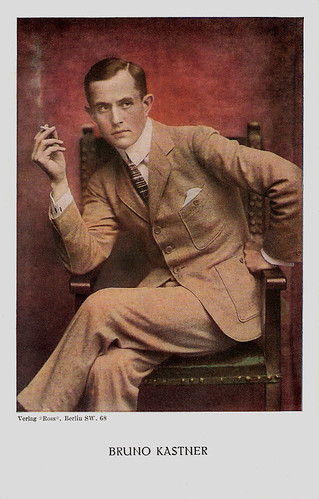
German postcard by Ross Verlag, Berlin, no. 2001/2. Photo: Becker & Maass. Also on Film Sterne, no. 138/1.
German actor Bruno Kastner (1890-1932) was one of the most beloved stars of the 1910s and 1920s. His parts as the elegant and charming dandy made him a heartthrob of the German silent cinema.
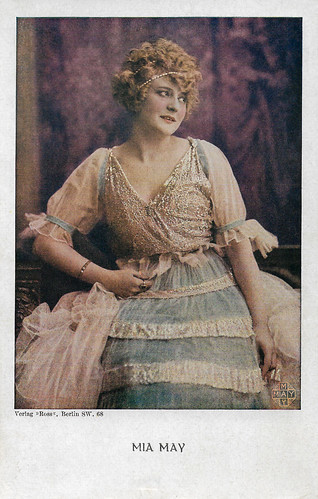
German postcard by Ross Verlag, Berlin, no. 2001/3. Photo: Becker & Maass / May Film. Also on Film Sterne, no. 105/4.
Mia May (1884-1980) was one of the first divas of the German cinema. She starred in many films of her husband, producer, writer, and director Joe May.
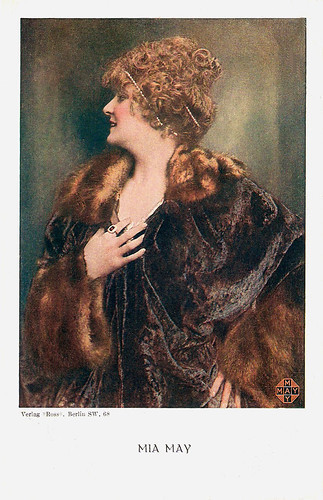
German postcard by Ross Verlag, Berlin, no. 2001/4. Photo: Becker & Maass / May Film. Also on Film Sterne, no. 105/1.
Mia May (1884-1980) was one of the first divas of the German cinema. She starred in many films of her husband, producer, writer, and director Joe May.
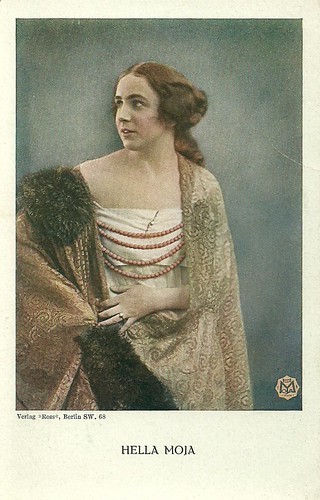
German postcard by Ross Verlag, Berlin, no. 2001/5. Photo: Becker & Maass / Hella Moja Film. Also on Film Sterne, no. 165/2.
During the First World War and the following years Hella Moja (1890-1951) was one of the most popular stars of the German silent cinema. There was even a Hella Moja serial and in 1918 she founded her own film company.
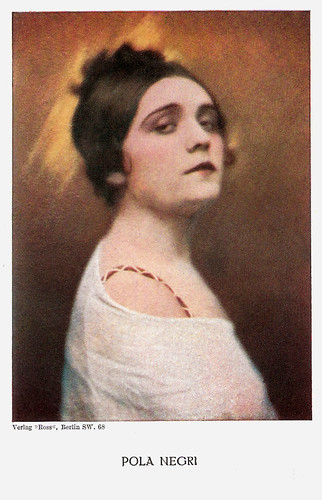
German postcard by Ross Verlag, Berlin, no. 2001/6. Photo: Anny Eberth. Also on Ross Verlag, no. 233, c. 1919-1920.
Polish film actress Pola Negri (1897-1987) achieved notoriety as a femme fatale in German and American silent films between the 1910s and 1930s. In the late 1910s and the 1920s, she achieved notoriety as a femme fatale in silent films in Poland, Berlin, and Hollywood. Negri was an overnight sensation in Lubitsch's Madame du Barry/Passion (1919).
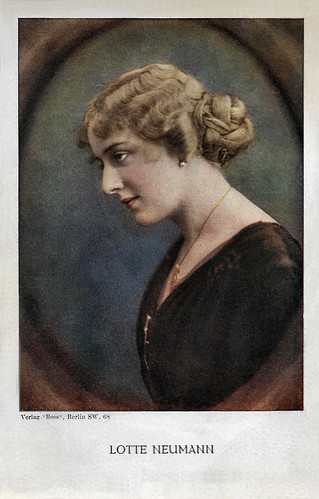
German postcard by Ross Verlag, Berlin, no. 2001/7. Photo: Becker & Maass. Also on Film Sterne, no. 194/3.
Lotte Neumann (1896-1977) was one of the most successful actresses in the early days of the German silent cinema. She also worked as a screenwriter and producer.
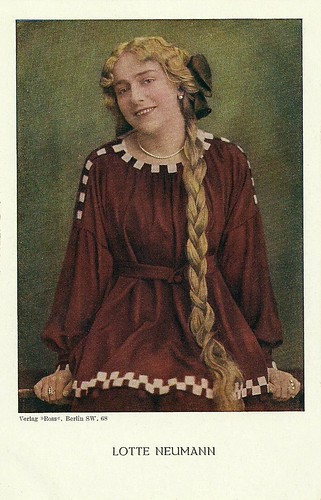
German postcard by Ross Verlag, Berlin, no. 2001/8. Photo: Becker & Maass. Also on Film Sterne, no. 150/2.
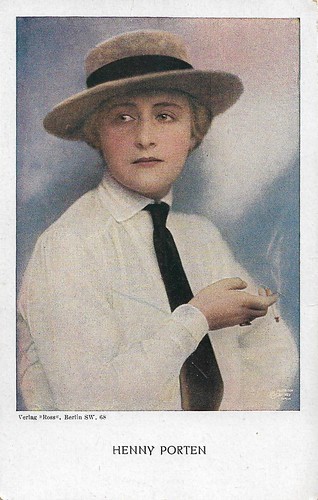
German postcard by Ross Verlag, Berlin, no. 2001/9. Photo: Becker & Maass / Messter Film, Berlin. Also on Ross Verlag, no. 303/1.
Sturdy and blond Henny Porten (1890-1960) was one of Germany's most important and popular film actresses of the silent cinema. She became the quintessence of German womanhood, ladylike yet kindhearted and a not a little petit bourgeois. She was also the producer of many of her own films.
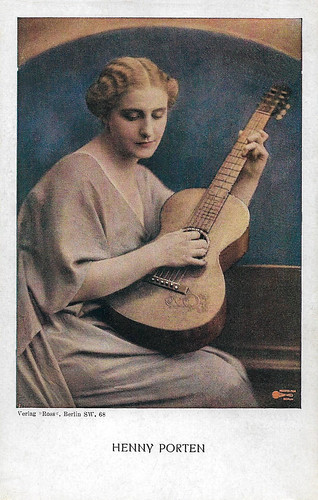
German postcard by Ross Verlag, Berlin, no. 2001/10. Photo: Becker & Maass / Messter Film, Berlin. Also on Ross Verlag, no. 301/3.
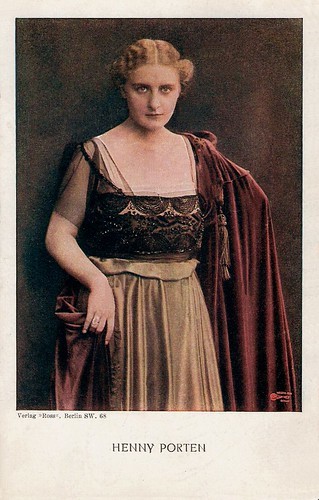
German postcard by Ross Verlag, Berlin, no. 2001/11. Photo: Becker & Maass / Messter Film. Also on Film Sterne, no. 215/1.
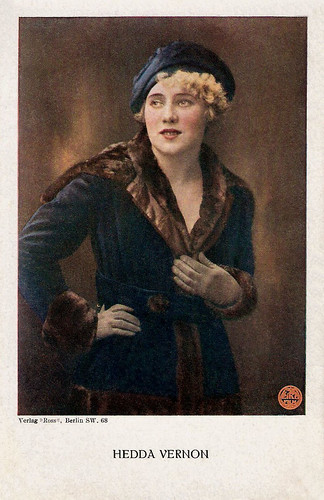
German postcard by Ross Verlag, no. 2001/12. Photo: Becker & Maass / Eiko Film. Also on Ross Verlag, no. 232/2.
German actress, writer, and producer Hedda Vernon (1886-1925) appeared in more than 60 films of the early silent period. During the 1910s she was such a popular film star that she got her own Hedda-Vernon serial.
With thanks to Mark Goffee and Jean Ritsema. Have you already checked out their Ross Verlag Movie Stars Postcards website? This Ross Verlag Tribute will be continued next week.

German postcard by Ross Verlag, Berlin, no. 2001/1. Photo: Fern Andra Atelier. See also: Film Sterne, no. 151/3.
'Modern' American actress Fern Andra (1893-1974) became one of the most popular film stars of the German cinema in the 1910s and early 1920s. In her films she mastered tightrope, riding a horse without a saddle, driving cars and motorcycles, bobsleighing, and even boxing.

German postcard by Ross Verlag, Berlin, no. 2001/2. Photo: Becker & Maass. Also on Film Sterne, no. 138/1.
German actor Bruno Kastner (1890-1932) was one of the most beloved stars of the 1910s and 1920s. His parts as the elegant and charming dandy made him a heartthrob of the German silent cinema.

German postcard by Ross Verlag, Berlin, no. 2001/3. Photo: Becker & Maass / May Film. Also on Film Sterne, no. 105/4.
Mia May (1884-1980) was one of the first divas of the German cinema. She starred in many films of her husband, producer, writer, and director Joe May.

German postcard by Ross Verlag, Berlin, no. 2001/4. Photo: Becker & Maass / May Film. Also on Film Sterne, no. 105/1.
Mia May (1884-1980) was one of the first divas of the German cinema. She starred in many films of her husband, producer, writer, and director Joe May.

German postcard by Ross Verlag, Berlin, no. 2001/5. Photo: Becker & Maass / Hella Moja Film. Also on Film Sterne, no. 165/2.
During the First World War and the following years Hella Moja (1890-1951) was one of the most popular stars of the German silent cinema. There was even a Hella Moja serial and in 1918 she founded her own film company.

German postcard by Ross Verlag, Berlin, no. 2001/6. Photo: Anny Eberth. Also on Ross Verlag, no. 233, c. 1919-1920.
Polish film actress Pola Negri (1897-1987) achieved notoriety as a femme fatale in German and American silent films between the 1910s and 1930s. In the late 1910s and the 1920s, she achieved notoriety as a femme fatale in silent films in Poland, Berlin, and Hollywood. Negri was an overnight sensation in Lubitsch's Madame du Barry/Passion (1919).

German postcard by Ross Verlag, Berlin, no. 2001/7. Photo: Becker & Maass. Also on Film Sterne, no. 194/3.
Lotte Neumann (1896-1977) was one of the most successful actresses in the early days of the German silent cinema. She also worked as a screenwriter and producer.

German postcard by Ross Verlag, Berlin, no. 2001/8. Photo: Becker & Maass. Also on Film Sterne, no. 150/2.

German postcard by Ross Verlag, Berlin, no. 2001/9. Photo: Becker & Maass / Messter Film, Berlin. Also on Ross Verlag, no. 303/1.
Sturdy and blond Henny Porten (1890-1960) was one of Germany's most important and popular film actresses of the silent cinema. She became the quintessence of German womanhood, ladylike yet kindhearted and a not a little petit bourgeois. She was also the producer of many of her own films.

German postcard by Ross Verlag, Berlin, no. 2001/10. Photo: Becker & Maass / Messter Film, Berlin. Also on Ross Verlag, no. 301/3.

German postcard by Ross Verlag, Berlin, no. 2001/11. Photo: Becker & Maass / Messter Film. Also on Film Sterne, no. 215/1.

German postcard by Ross Verlag, no. 2001/12. Photo: Becker & Maass / Eiko Film. Also on Ross Verlag, no. 232/2.
German actress, writer, and producer Hedda Vernon (1886-1925) appeared in more than 60 films of the early silent period. During the 1910s she was such a popular film star that she got her own Hedda-Vernon serial.
With thanks to Mark Goffee and Jean Ritsema. Have you already checked out their Ross Verlag Movie Stars Postcards website? This Ross Verlag Tribute will be continued next week.
Published on October 29, 2024 23:00
October 28, 2024
La Collectionneuse: Edwina Booth
Trader Horn (1931) made Edwina Booth famous. Unfortunately, it also marked the beginning of a nightmare for the young actress, whose health was seriously impaired because of tropical ailments she contracted while filming the movie in Africa. Her once-promising career was over by 1933 and she soon disappeared from view in the second half of the 1930s.
In an interview in November 1934, a shattered and disillusioned Edwina made a heart-rending statement: "I’ve been away so long that nothing matters now. I went home to die, but I wasn’t that fortunate. I’ve only learned what it means to die, to be away, to be denied life, to know that I may just remain like this, so weak that you cry when you want to talk; to have pain so shooting through your head; to want to walk and be unable; to lie on your back in a darkened room, away from the sunshine you hate, and know that outside, the parade has passed you by and that you’ll never be able to catch up with it again".
When she passed away in 1991, her brother declared: "Her death has been wrongly reported so many times. But this time, she really did die".
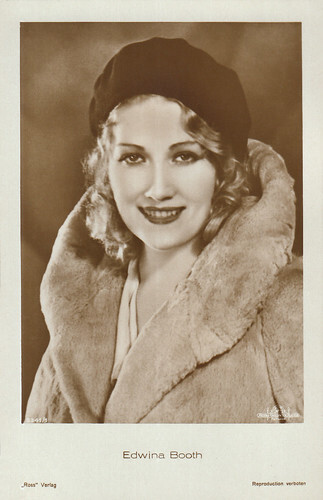
German postcard by Ross Verlag, no. 5341/1, 1930-1931. Photo: Metro Goldwyn Mayer.
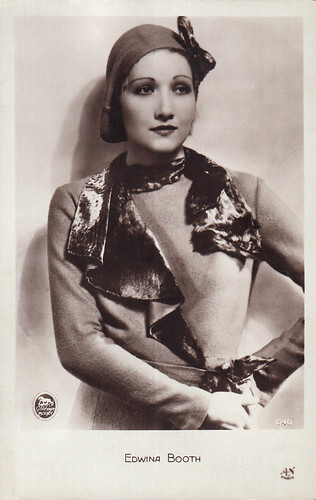
French postcard nu A.N., Paris, no. 640. Photo: Goldwyn-Mayer.
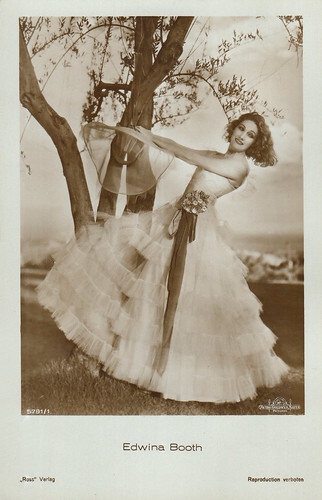
German postcard by Ross Verlag, no. 5781/1, 1930-1931. Photo: Metro Goldwyn Mayer.
Beginnings
Edwina Booth was born Josephine Constance Woodruff on the 13th of September 1904 in Provo, Utah, U.S.A.
Her parents were James Lloyd Woodruff and Josephine Diantha Booth. The family finally settled in California.
There, in 1926, the young and pretty Josephine Constance was noticed by assistant film director E.J. Babille, who worked for the Metropolitan Pictures Corporation. So, she made her screen debut in a bit part in a Marie Prevost vehicle, For Wives Only (Victor Heerman, 1926).
She chose Edwina Booth as a pseudonym, 'Edwin' being the first name of an uncle and 'Booth' being the family name on her mother’s side. Over the next few years, she had some more uncredited roles in several films.
She also worked as a chorus girl in the 'Music Box Revue' in Hollywood and, thanks to actress Lucille La Verne, she appeared in two stage plays in Los Angeles and San Francisco.
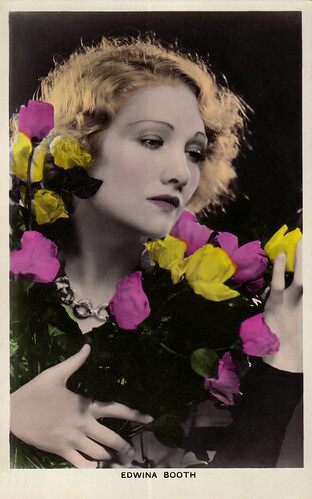
British postcard in the Colourgraph Series, London, no. C172.
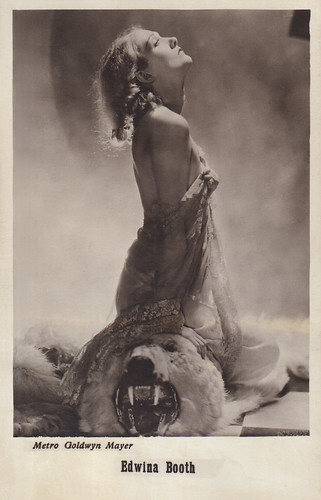
Italian postcard by G.B. Falci, Milano. Photo: Metro Goldwyn Mayer.
Trader Horn
At the end of the 1920s, M.G.M. decided to bring to the screen the bestselling book 'Trader Horn' and to make it the first non-documentary film shot on location in Africa.
Harry Carey and Duncan Renaldo were signed for the two male leads. The heroine, a missionary’s daughter who had been kidnapped as a kid by an African tribe and who had grown up to become their beautiful and fiery White Goddess, was more difficult to find.
Director W.S. Van Dyke wanted a lovely blonde able to display a volatile temperament on screen and finally chose Edwina Booth. The crew began their long trip to Africa at the end of March 1929 and arrived in May.
Filming Trader Horn became a nightmare for Edwina, whose fragile skin was bruised by sharp weeds and who suffered from severe sunburns and various insect bites.When she came back to the U.S.A. in December, her health had deteriorated.
She spent most of 1930 doing Trader Horn retakes at M.G.M. At the end of the year, Duncan Renaldo’s wife filed a suit against the actress for alienation of her husband’s affection. Edwina won the case in September 1931.
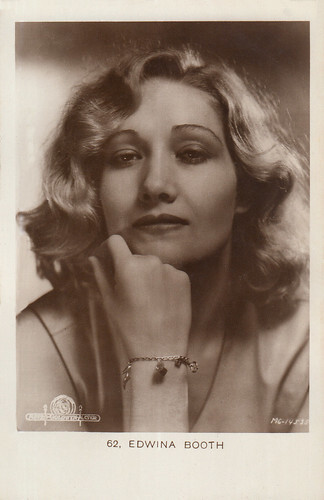
Belgian postcard by P.I.A. Belgaphot, Bruxelles, no. 62. Photo: Metro Goldwyn Mayer.
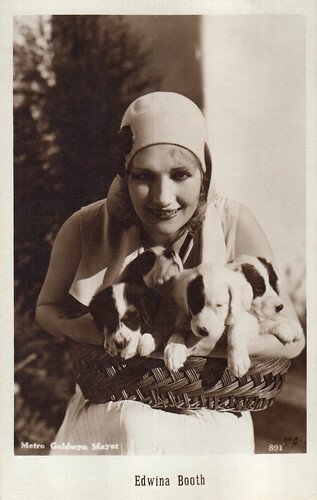
Italian postcard by G.B. Falci Editore, Milano, no. 891. Photo: Metro Goldwyn Mayer.
A promising movie career was quickly cut short
Trader Horn premiered on the 22nd of January 1931 and was a crowd-pleaser upon its release. Edwina Booth was now a household name.
Unfortunately, she wouldn’t enjoy her success for long. After M.G.M. had released Edwina from her contract, she only could find work at Poverty Row studios.
For Mascot Pictures, she was featured in two serials, The Vanishing Legion (1931) and Last of the Mohicans (1932), both with Harry Carey again.
At Monogram, she appeared in The Midnight Patrol (1932), alongside two other female stars on the wane, Betty Bronson and Mary Nolan .
She was then reunited with Duncan Renaldo in Trapped in Ti Juana (1932), produced by Action Pictures, which marked the end of her film career.
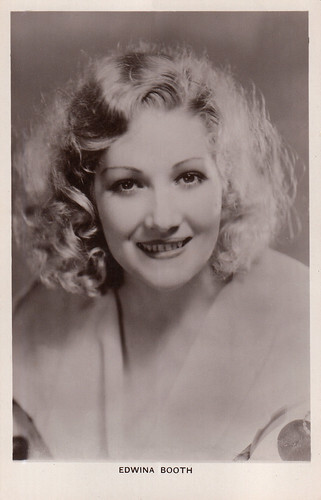
British postcard in the Picturegoer series, no. 560.
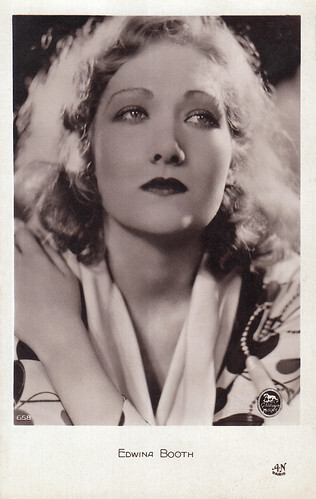
French postcard by A.N., Paris, no. 658. Photo: Metro Goldwyn Mayer.
Her battle with the disease
Her health worsening, Edwina Booth subsequently spent most of her time in seclusion in darkened rooms. The costs of medical bills led the family to apply for public assistance.
In October 1933, she filed suit against M.G.M. for $1.000.000, claiming that she was permanently injured and incapacitated from further work due to the health impairments she had suffered from during the filming of Trader Horn. Three medical experts stated that the African sun and insect’ bites had shattered her nervous system and caused her invalidity.
The case was settled out of court for much less money than she had asked for. In 1935, she travelled to Europe to seek medical advice from tropical disease specialists in England, Switzerland, and Austria.
In a letter she wrote at the time to her former nurse, Edwina stated that a Viennese physician had found that her blood had been poisoned by bites of tsetse flies and that the nerve centre situated in her neck had been burned out by the sun. One of Edwina’s cousins remembered that she was diagnosed with sleeping sickness.
She came back to the States in April 1936. In June, she rallied enough to speak to the press about a possible screen comeback, but it would never happen, as her health never improved enough for her to work in movies again.
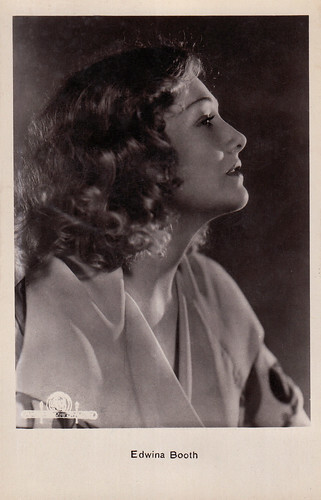
Belgian postcard by P.I.A. Belgaphot, Bruxelles.
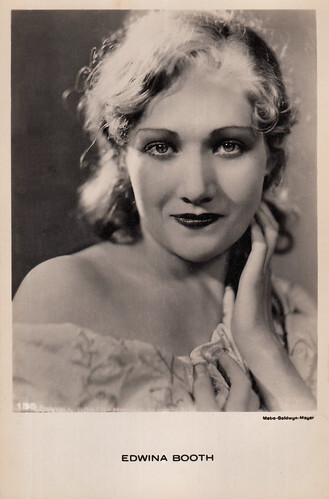
Dutch postcard, no. 156. Photo: Metro-Goldwyn-Mayer.
Drifting into obscurity
Edwina Booth then drifted into obscurity. Over the years, her death would be wrongly reported several times, but she didn’t even bother to dispel those unfounded rumours.
In 1951, she married widower Uriel Higham. He was not her first spouse as her marriage to Anthony Schuck was annulled in 1930.
After her husband died in 1956, she devoted much time to the Los Angeles Latter Day Saints Temple.
She remarried in 1959 with Reinold Fehlberg, who passed away in 1984. Edwina Booth died on the 18th of May 1991 of a heart failure.
Considering the serious health problems she had encountered in her life, she amazingly had reached the age of 86 years.
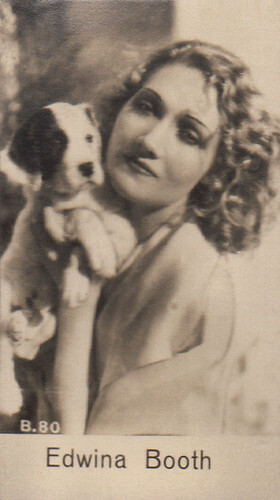
Cigarette card, no. B.80.
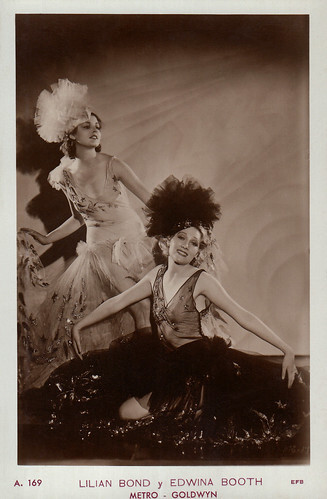
Spanish postcard by Editorial Fotografica, Barcelona, no. A. 169. Photo: Metro-Goldwyn-Mayer. Edwina Booth and Lillian Bond .
Text and postcards: Marlene Pilaete.
In an interview in November 1934, a shattered and disillusioned Edwina made a heart-rending statement: "I’ve been away so long that nothing matters now. I went home to die, but I wasn’t that fortunate. I’ve only learned what it means to die, to be away, to be denied life, to know that I may just remain like this, so weak that you cry when you want to talk; to have pain so shooting through your head; to want to walk and be unable; to lie on your back in a darkened room, away from the sunshine you hate, and know that outside, the parade has passed you by and that you’ll never be able to catch up with it again".
When she passed away in 1991, her brother declared: "Her death has been wrongly reported so many times. But this time, she really did die".

German postcard by Ross Verlag, no. 5341/1, 1930-1931. Photo: Metro Goldwyn Mayer.

French postcard nu A.N., Paris, no. 640. Photo: Goldwyn-Mayer.

German postcard by Ross Verlag, no. 5781/1, 1930-1931. Photo: Metro Goldwyn Mayer.
Beginnings
Edwina Booth was born Josephine Constance Woodruff on the 13th of September 1904 in Provo, Utah, U.S.A.
Her parents were James Lloyd Woodruff and Josephine Diantha Booth. The family finally settled in California.
There, in 1926, the young and pretty Josephine Constance was noticed by assistant film director E.J. Babille, who worked for the Metropolitan Pictures Corporation. So, she made her screen debut in a bit part in a Marie Prevost vehicle, For Wives Only (Victor Heerman, 1926).
She chose Edwina Booth as a pseudonym, 'Edwin' being the first name of an uncle and 'Booth' being the family name on her mother’s side. Over the next few years, she had some more uncredited roles in several films.
She also worked as a chorus girl in the 'Music Box Revue' in Hollywood and, thanks to actress Lucille La Verne, she appeared in two stage plays in Los Angeles and San Francisco.

British postcard in the Colourgraph Series, London, no. C172.

Italian postcard by G.B. Falci, Milano. Photo: Metro Goldwyn Mayer.
Trader Horn
At the end of the 1920s, M.G.M. decided to bring to the screen the bestselling book 'Trader Horn' and to make it the first non-documentary film shot on location in Africa.
Harry Carey and Duncan Renaldo were signed for the two male leads. The heroine, a missionary’s daughter who had been kidnapped as a kid by an African tribe and who had grown up to become their beautiful and fiery White Goddess, was more difficult to find.
Director W.S. Van Dyke wanted a lovely blonde able to display a volatile temperament on screen and finally chose Edwina Booth. The crew began their long trip to Africa at the end of March 1929 and arrived in May.
Filming Trader Horn became a nightmare for Edwina, whose fragile skin was bruised by sharp weeds and who suffered from severe sunburns and various insect bites.When she came back to the U.S.A. in December, her health had deteriorated.
She spent most of 1930 doing Trader Horn retakes at M.G.M. At the end of the year, Duncan Renaldo’s wife filed a suit against the actress for alienation of her husband’s affection. Edwina won the case in September 1931.

Belgian postcard by P.I.A. Belgaphot, Bruxelles, no. 62. Photo: Metro Goldwyn Mayer.

Italian postcard by G.B. Falci Editore, Milano, no. 891. Photo: Metro Goldwyn Mayer.
A promising movie career was quickly cut short
Trader Horn premiered on the 22nd of January 1931 and was a crowd-pleaser upon its release. Edwina Booth was now a household name.
Unfortunately, she wouldn’t enjoy her success for long. After M.G.M. had released Edwina from her contract, she only could find work at Poverty Row studios.
For Mascot Pictures, she was featured in two serials, The Vanishing Legion (1931) and Last of the Mohicans (1932), both with Harry Carey again.
At Monogram, she appeared in The Midnight Patrol (1932), alongside two other female stars on the wane, Betty Bronson and Mary Nolan .
She was then reunited with Duncan Renaldo in Trapped in Ti Juana (1932), produced by Action Pictures, which marked the end of her film career.

British postcard in the Picturegoer series, no. 560.

French postcard by A.N., Paris, no. 658. Photo: Metro Goldwyn Mayer.
Her battle with the disease
Her health worsening, Edwina Booth subsequently spent most of her time in seclusion in darkened rooms. The costs of medical bills led the family to apply for public assistance.
In October 1933, she filed suit against M.G.M. for $1.000.000, claiming that she was permanently injured and incapacitated from further work due to the health impairments she had suffered from during the filming of Trader Horn. Three medical experts stated that the African sun and insect’ bites had shattered her nervous system and caused her invalidity.
The case was settled out of court for much less money than she had asked for. In 1935, she travelled to Europe to seek medical advice from tropical disease specialists in England, Switzerland, and Austria.
In a letter she wrote at the time to her former nurse, Edwina stated that a Viennese physician had found that her blood had been poisoned by bites of tsetse flies and that the nerve centre situated in her neck had been burned out by the sun. One of Edwina’s cousins remembered that she was diagnosed with sleeping sickness.
She came back to the States in April 1936. In June, she rallied enough to speak to the press about a possible screen comeback, but it would never happen, as her health never improved enough for her to work in movies again.

Belgian postcard by P.I.A. Belgaphot, Bruxelles.

Dutch postcard, no. 156. Photo: Metro-Goldwyn-Mayer.
Drifting into obscurity
Edwina Booth then drifted into obscurity. Over the years, her death would be wrongly reported several times, but she didn’t even bother to dispel those unfounded rumours.
In 1951, she married widower Uriel Higham. He was not her first spouse as her marriage to Anthony Schuck was annulled in 1930.
After her husband died in 1956, she devoted much time to the Los Angeles Latter Day Saints Temple.
She remarried in 1959 with Reinold Fehlberg, who passed away in 1984. Edwina Booth died on the 18th of May 1991 of a heart failure.
Considering the serious health problems she had encountered in her life, she amazingly had reached the age of 86 years.

Cigarette card, no. B.80.

Spanish postcard by Editorial Fotografica, Barcelona, no. A. 169. Photo: Metro-Goldwyn-Mayer. Edwina Booth and Lillian Bond .
Text and postcards: Marlene Pilaete.
Published on October 28, 2024 23:00
October 27, 2024
Jackie Brown (1997)
Is Jackie Brown (1997) Quentin Tarantino’s most underrated film? It’s less showy than Pulp Fiction (1994), Kill Bill (2003-2004) and Once Upon a Time... in Hollywood` (2019), Jackie Brown brings the past into the present with a great cast including Pam Grier star of many 1970s blaxploitation films, and Robert Forster, lot of sweet soul music and Elmore Leonard’s story involving multiple double-crossings and nasty murders, and a great love story.
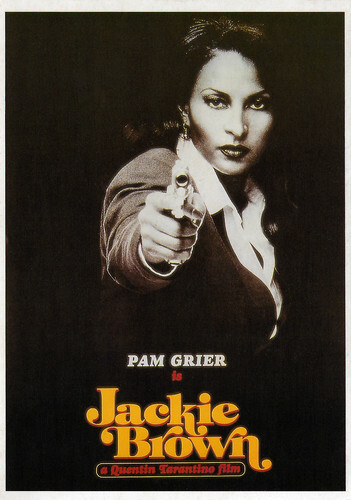
Vintage postcard in the Cinemascope Collection, no. 137. Pam Grier as Jackie Brown in Jackie Brown (Quentin Tarantino, 1997).
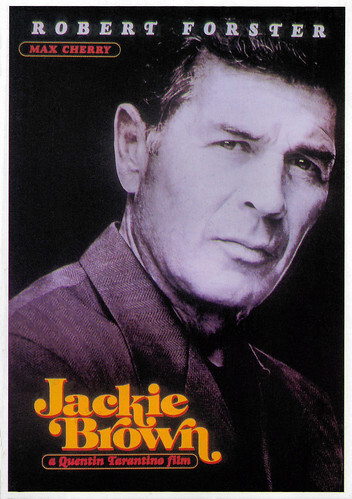
Vintage postcard in the Cinemascope Collection, no. 138. Robert Forster as Max Cherry in Jackie Brown (Quentin Tarantino, 1997).
Elevating a crime novel to a form of sociological comedy
Jackie Brown (Quentin Tarantino, 1997) is the first feature-length film directed by Quentin Tarantino that was based on another work. While adapting Elmore Leonard’s 'Rum Punch' into a screenplay, Tarantino changed the ethnicity of the main character from white to black, as well as renaming her from Burke to Brown, titling the screenplay 'Jackie Brown'.
Tarantino hesitated to discuss the changes with Leonard, finally speaking with the author as the film was about to start shooting. Leonard loved the screenplay. He considered it not only the best of the twenty-six screen adaptations of his novels and short stories but also stated that it was possibly the best screenplay he had ever read.
In his 1997 review of Tarantino’s third film, Roger Ebert wrote: “This is the movie that proves Tarantino is the real thing, and not just a two-film wonder boy’ It's not a retread of Reservoir Dogs or Pulp Fiction, but a new film in a new style, and it evokes the particular magic of Elmore Leonard - who elevates the crime novel to a form of sociological comedy.
There is a scene here that involves the ex-con Louis ( Robert De Niro ) and Ordell's druggie mistress (Bridget Fonda) discussing a photograph pinned to the wall, and it's so perfectly written, timed and played that I applauded it. Tarantino has a lot of good scenes in this movie.
The scene where one character lures another to his death by tempting him with chicken and waffles. The scene where a nagging woman makes one suggestion too many. The scene where a man comes around in the morning to get back the gun a woman borrowed the night before. The moment when Jackie Brown uses one line of dialogue, perfectly timed, to solve all of her problems.”
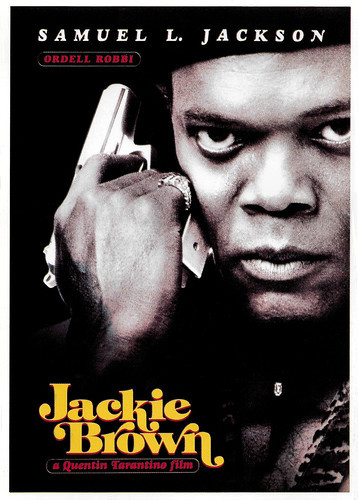
French postcard, no. 655. Samuel L. Jackson as Ordell Robbi in Jackie Brown (Quentin Tarantino, 1997).
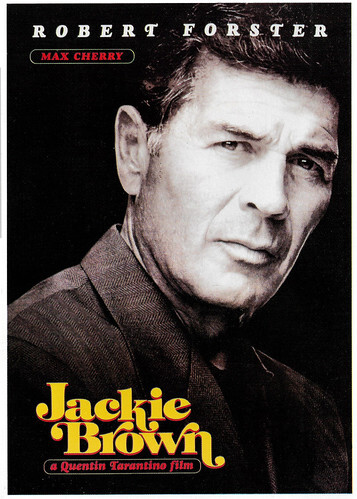
French postcard, no. 657. Robert Forster as Max Cherry in Jackie Brown (Quentin Tarantino, 1997).
Tarantino's gift is casting
If Quentin Tarantino 's strengths are dialogue and plotting, his gift is casting. Pam Grier, goddess of 1970s grindhouse films who, by the 1990s, wasn’t exactly seeing the plum roles pour in, here finds just the right note for Jackie Brown, a tired and desperate flight attendant for a low-rent airline.
Jackie makes a little scratch on the side by smuggling money for her firearms dealer boss (Samuel L. Jackson), but she gets busted. Robert Forster, another actor who’d practically been forgotten at the time, has the role of a career as bail bondsman Max Cherry. Max is a plausible professional, not a plot stooge. Matter of fact about his job and the law, Cherry gets her out of jail and instantly falls in love with her.
Jackson, as Ordell, does a harder, colder version of his hit man in Pulp Fiction, and once again uses the N-word like an obsession or a mantra. Robert De Niro , still in a longtime convict's prison trance, plays Louis as ingratiatingly stupid. Bridget Fonda's performance is so good, it's almost invisible; her character's lassitude and contempt coexist with the need to be high all the time.
Songs by a variety of artists are heard throughout the film, including The Delfonics' 'La-La Means I Love You' and 'Didn't I (Blow Your Mind This Time)', Bill Withers' 'Who Is He', The Grass Roots' 'Midnight Confessions', Johnny Cash's 'Tennessee Stud', Bloodstone's 'Natural High', and Foxy Brown's '(Holy Matrimony) Married to the Firm'.
There are several songs included that were featured in blaxploitation films as well, including Bobby Womack's 'Across 110th Street', from the film Across 110th Street (Barry Shear, 1972), and Pam Grier's 'Long Time Woman', from her film The Big Doll House (Jack Hill, 1971). The original soundtrack also features separate tracks with dialogue from the film. Instead of using a new film score, Tarantino incorporated Roy Ayers' funk score from the film Coffy (Jack Hill, 1973).
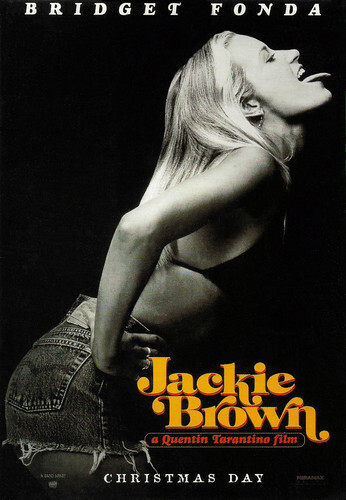
French postcard by Sonis, no. C 867. Photo: Miramax / A Band Apart / BAC Films. Bridget Fonda as Melanie Ralston in Jackie Brown (Quentin Tarantino, 1997). Caption: Christmas Day.
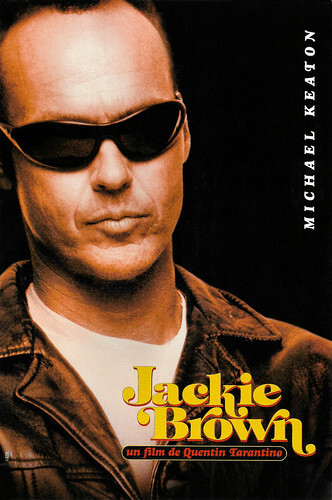
French promotion card by BacFilms. Michael Keaton as Ray Nicolette in Jackie Brown (Quentin Tarantino, 1997).
A love letter to the second chance
Jackie Brown (1997) received positive reviews and grossed $74.7 million worldwide on a $12 million budget. Roger Ebert: "You savour every moment of Jackie Brown. Those who say it is too long have developed cinematic attention deficit disorder. I wanted these characters to live, talk, deceive and scheme for hours and hours."
It earned a nomination for the Academy Award for Best Supporting Actor for Robert Forster, and Golden Globe Award nominations for Samuel Jackson and Pam Grier. The film revitalised the careers of Grier and Forster, neither of whom had been cast in a lead role for many years.
Jackie Brown also attracted criticism for its use of the racial slur ‘nigger’, which is used 38 times. During an interview with Manohla Dargis, Tarantino said: "The minute any word has that much power, as far as I'm concerned, everyone on the planet should scream it. No word deserves that much power."
Director Spike Lee: "I'm not against the word, and I use it, but not excessively. And some people speak that way. But, Quentin is infatuated with that word. What does he want to be made – an honorary black man?" Lee took his concerns to the film's producers, Harvey Weinstein and Lawrence Bender. But in Tarantino’s later films Django Unchained (2012) and The Hateful Eight (2015), the word was even used more.
In 2023, Time magazine chose Jackie Brown as one of the 10 best films of the 1990s. In her comment, Time ’s Stepanie Zacharek concluded: "Yet the movie is filled with love, chiefly Tarantino’s love for Forster and Grier, two actors he was nuts about as a kid, and they’re glorious here. Jackie Brown is Tarantino’s warmest movie, a love letter to the second chance. Everybody deserves one.” And is Jackie Brown (1997) Quentin Tarantino ’s most underrated film? We think so.
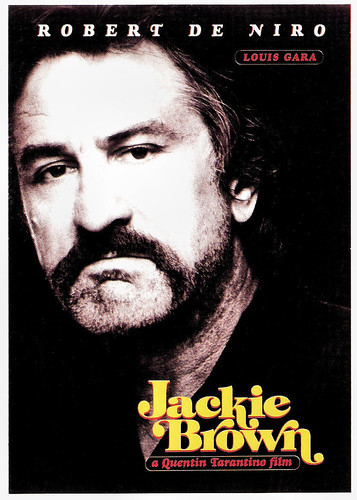
French postcard, no. 654. Photo: publicity still for Jackie Brown. (Quentin Tarantino, 1997) with Robert De Niro as Louis Gara.
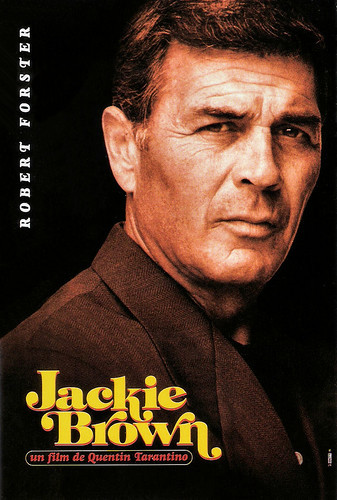
French promotion card by BacFilms. Robert Forster in Jackie Brown (Quentin Tarantino, 1997).
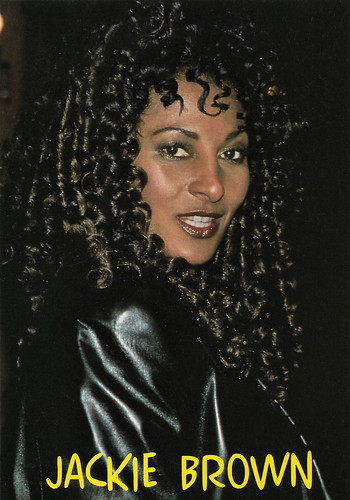
British postcard by Heroes Publishing LTD, London, no. SFC 3308. Pam Grier in Jackie Brown (Quentin Tarantino, 1997).
Sources: Stephanie Zacharek (Time), Roger Ebert (Roger Ebert.com), Claudio Carvalho (IMDb), Wikipedia and IMDb.

Vintage postcard in the Cinemascope Collection, no. 137. Pam Grier as Jackie Brown in Jackie Brown (Quentin Tarantino, 1997).

Vintage postcard in the Cinemascope Collection, no. 138. Robert Forster as Max Cherry in Jackie Brown (Quentin Tarantino, 1997).
Elevating a crime novel to a form of sociological comedy
Jackie Brown (Quentin Tarantino, 1997) is the first feature-length film directed by Quentin Tarantino that was based on another work. While adapting Elmore Leonard’s 'Rum Punch' into a screenplay, Tarantino changed the ethnicity of the main character from white to black, as well as renaming her from Burke to Brown, titling the screenplay 'Jackie Brown'.
Tarantino hesitated to discuss the changes with Leonard, finally speaking with the author as the film was about to start shooting. Leonard loved the screenplay. He considered it not only the best of the twenty-six screen adaptations of his novels and short stories but also stated that it was possibly the best screenplay he had ever read.
In his 1997 review of Tarantino’s third film, Roger Ebert wrote: “This is the movie that proves Tarantino is the real thing, and not just a two-film wonder boy’ It's not a retread of Reservoir Dogs or Pulp Fiction, but a new film in a new style, and it evokes the particular magic of Elmore Leonard - who elevates the crime novel to a form of sociological comedy.
There is a scene here that involves the ex-con Louis ( Robert De Niro ) and Ordell's druggie mistress (Bridget Fonda) discussing a photograph pinned to the wall, and it's so perfectly written, timed and played that I applauded it. Tarantino has a lot of good scenes in this movie.
The scene where one character lures another to his death by tempting him with chicken and waffles. The scene where a nagging woman makes one suggestion too many. The scene where a man comes around in the morning to get back the gun a woman borrowed the night before. The moment when Jackie Brown uses one line of dialogue, perfectly timed, to solve all of her problems.”

French postcard, no. 655. Samuel L. Jackson as Ordell Robbi in Jackie Brown (Quentin Tarantino, 1997).

French postcard, no. 657. Robert Forster as Max Cherry in Jackie Brown (Quentin Tarantino, 1997).
Tarantino's gift is casting
If Quentin Tarantino 's strengths are dialogue and plotting, his gift is casting. Pam Grier, goddess of 1970s grindhouse films who, by the 1990s, wasn’t exactly seeing the plum roles pour in, here finds just the right note for Jackie Brown, a tired and desperate flight attendant for a low-rent airline.
Jackie makes a little scratch on the side by smuggling money for her firearms dealer boss (Samuel L. Jackson), but she gets busted. Robert Forster, another actor who’d practically been forgotten at the time, has the role of a career as bail bondsman Max Cherry. Max is a plausible professional, not a plot stooge. Matter of fact about his job and the law, Cherry gets her out of jail and instantly falls in love with her.
Jackson, as Ordell, does a harder, colder version of his hit man in Pulp Fiction, and once again uses the N-word like an obsession or a mantra. Robert De Niro , still in a longtime convict's prison trance, plays Louis as ingratiatingly stupid. Bridget Fonda's performance is so good, it's almost invisible; her character's lassitude and contempt coexist with the need to be high all the time.
Songs by a variety of artists are heard throughout the film, including The Delfonics' 'La-La Means I Love You' and 'Didn't I (Blow Your Mind This Time)', Bill Withers' 'Who Is He', The Grass Roots' 'Midnight Confessions', Johnny Cash's 'Tennessee Stud', Bloodstone's 'Natural High', and Foxy Brown's '(Holy Matrimony) Married to the Firm'.
There are several songs included that were featured in blaxploitation films as well, including Bobby Womack's 'Across 110th Street', from the film Across 110th Street (Barry Shear, 1972), and Pam Grier's 'Long Time Woman', from her film The Big Doll House (Jack Hill, 1971). The original soundtrack also features separate tracks with dialogue from the film. Instead of using a new film score, Tarantino incorporated Roy Ayers' funk score from the film Coffy (Jack Hill, 1973).

French postcard by Sonis, no. C 867. Photo: Miramax / A Band Apart / BAC Films. Bridget Fonda as Melanie Ralston in Jackie Brown (Quentin Tarantino, 1997). Caption: Christmas Day.

French promotion card by BacFilms. Michael Keaton as Ray Nicolette in Jackie Brown (Quentin Tarantino, 1997).
A love letter to the second chance
Jackie Brown (1997) received positive reviews and grossed $74.7 million worldwide on a $12 million budget. Roger Ebert: "You savour every moment of Jackie Brown. Those who say it is too long have developed cinematic attention deficit disorder. I wanted these characters to live, talk, deceive and scheme for hours and hours."
It earned a nomination for the Academy Award for Best Supporting Actor for Robert Forster, and Golden Globe Award nominations for Samuel Jackson and Pam Grier. The film revitalised the careers of Grier and Forster, neither of whom had been cast in a lead role for many years.
Jackie Brown also attracted criticism for its use of the racial slur ‘nigger’, which is used 38 times. During an interview with Manohla Dargis, Tarantino said: "The minute any word has that much power, as far as I'm concerned, everyone on the planet should scream it. No word deserves that much power."
Director Spike Lee: "I'm not against the word, and I use it, but not excessively. And some people speak that way. But, Quentin is infatuated with that word. What does he want to be made – an honorary black man?" Lee took his concerns to the film's producers, Harvey Weinstein and Lawrence Bender. But in Tarantino’s later films Django Unchained (2012) and The Hateful Eight (2015), the word was even used more.
In 2023, Time magazine chose Jackie Brown as one of the 10 best films of the 1990s. In her comment, Time ’s Stepanie Zacharek concluded: "Yet the movie is filled with love, chiefly Tarantino’s love for Forster and Grier, two actors he was nuts about as a kid, and they’re glorious here. Jackie Brown is Tarantino’s warmest movie, a love letter to the second chance. Everybody deserves one.” And is Jackie Brown (1997) Quentin Tarantino ’s most underrated film? We think so.

French postcard, no. 654. Photo: publicity still for Jackie Brown. (Quentin Tarantino, 1997) with Robert De Niro as Louis Gara.

French promotion card by BacFilms. Robert Forster in Jackie Brown (Quentin Tarantino, 1997).

British postcard by Heroes Publishing LTD, London, no. SFC 3308. Pam Grier in Jackie Brown (Quentin Tarantino, 1997).
Sources: Stephanie Zacharek (Time), Roger Ebert (Roger Ebert.com), Claudio Carvalho (IMDb), Wikipedia and IMDb.
Published on October 27, 2024 23:00
October 26, 2024
Jane Greer
American film and television actress Jane Greer (1924-2001) started her career as a model and a big band singer. Throughout her career, she starred in 28 films and 17 TV series. Greer is best known for her role as the sassy, sensual femme fatale Kathie Moffat in the Film Noir Out of the Past (1947). Its complex, fatalistic storyline, dark cinematography, and classic femme fatale garnered the film critical acclaim and cult status.
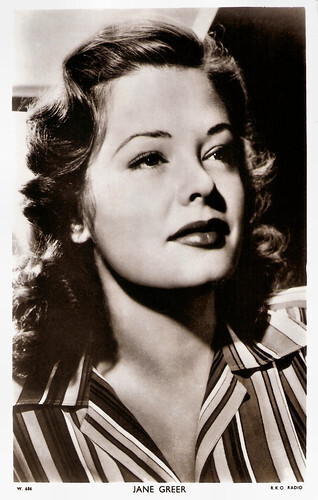
British postcard in the Picturegoer Series, London no. W. 686. Photo: R.K.O. Radio.
The golden cage of Howard Hughes
Bette Jane Greer was born in Washington, D.C., in 1924. She was the daughter of Charles Durell McClellan Greer Jr. and his wife, Bettie, who wrote children's stories. As a baby, ‘Bettejane’ already won a beauty contest and from her teenage years, she worked as a model for furs. At 15, she suffered facial paralysis and she later claimed that it was the subsequent therapeutic exercises that enabled her to express herself as an actress.
Thanks to her good looks and her attractive contralto voice she first started a career as a singer. She dropped out of her senior year at high school to work as a vocalist in a nightclub. She mostly sang for Enric Madriguera's orchestra at the Latin Club Del Rio in Washington, D.C. and sang phonetically in Spanish. She also performed on the radio where she met singer, entertainer, actor and bandleader Rudy Vallee.
In 1942, Bettejane appeared on the cover of Life magazine modelling army uniforms for women. The eccentric billionaire Howard Hughes reportedly noticed the 18-year-old and gave her a contract with RKO Pictures. Hughes managed to keep Greer under a kind of house arrest for five months. "Hughes was obsessed with me," she said many years later. "But at first it seemed as if he were offering me a superb career opportunity." She flew the obsessed Hughes and quickly married Rudy Vallee in 1943. An enraged Hughes pressured her and ruined the marriage. The couple separated after three months and divorced in 1944.
She returned to Hughes and her contract. At first, RKO gave her bit parts as showgirls in three films under her real name Bettejane Greer. She made her uncredited film debut in the romantic comedy Pan-Americana (John H. Auer, 1945). In 1945, Greer had her name legally changed to Jane Greer by a court in Los Angeles. She had bigger roles in the Film Noir Two O'Clock Courage (Anthony Mann, 1945) and Dick Tracy (William Berke, 1945), starring Russ Conway. This was a film adaptation of the Dick Tracy comic strip created by Chester Gould. It was the first of four instalments of the Dick Tracy film series, released by RKO Radio Pictures.
Greer had her breakthrough as femme fatale Kathie Moffat in the now classic Film Noir Out of the Past (Jacques Tourneur, 1947). Ronald Bergan in The Guardian: “She came into her own as one of the great two-timing dames in Jacques Tourneur's superb film noir Out of The Past, a part that was enough to make her one of the icons of the genre. As the femme fatale who coldly seduces Robert Mitchum in his first starring role, Greer changes character expertly to suit her particular needs, remote one moment, charming the next.” Greer co-starred with Robert Young and Susan Hayward in the Film Noir They Won't Believe Me (Irving Pichel, 1947), produced by Alfred Hitchcock 's longtime assistant and collaborator, Joan Harrison.
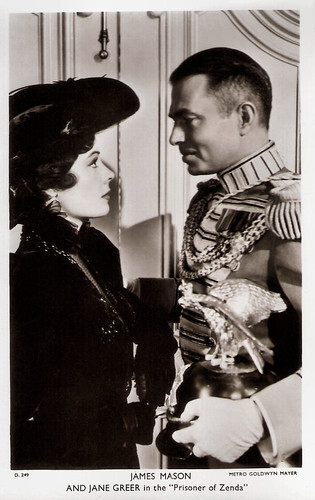
British postcard in the Picturegoer Series, London, no. D. 249. Photo: Metro-Goldwyn-Mayer. James Mason and Jane Greer in The Prisoner of Zenda (Richard Thorpe, 1952).
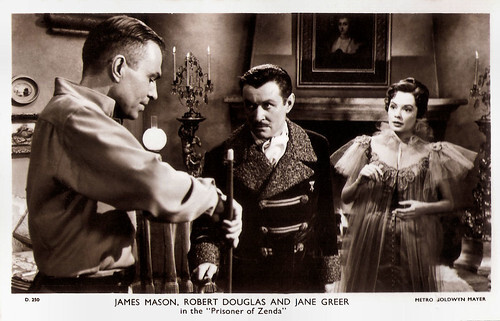
British postcard in the Picturegoer Series, London, no. D. 250. Photo: Metro-Goldwyn-Mayer. James Mason , Robert Douglas and Jane Greer in The Prisoner of Zenda (Richard Thorpe, 1952).
As long as I own the studio, you won't work
In 1947, Jane Greer married the lawyer and businessman Edward Lasker with whom she had three children. Even though Greer was now married, Hughes, in a noirish twist of fate, had just bought RKO, and was still interested in her romantically, writes Ronald Bergan. When Greer resisted him, Hughes barked out, "As long as I own the studio, you won't work." However, he relented and cast her to co-star once again with starred alongside Robert Mitchum , in another Film Noir, the fast-paced The Big Steal (Don Siegel, 1949).
Greer's last film for RKO was The Company She Keeps (1950) as a deceitful ex-con, making a play for the boyfriend of her parole officer ( Lizabeth Scott ). In one scene, the baby in her arms is Jeff Bridges , making his screen debut. At MGM, she appeared in the war comedy You're in the Navy Now (Henry Hathaway, 1951) opposite Gary Cooper .
In 1952, Greer co-starred in one of her best-known films, the Swashbuckler The Prisoner of Zenda (Richard Thorpe, 1952). Opposite Stewart Granger and James Mason , she was great as the plotting Antoinette de Mauban. In 1953, Greer largely withdrew from the film business for her family life. In the following decades, she only took on roles sporadically. Most were guest appearances in television series.
In the cinema, she co-starred with James Cagney in the dark dramatic film Man of a Thousand Faces (Joseph Pevney, 1957) detailing the life of silent film actor Lon Chaney . She played the second wife of Chaney. In 1984, she played the role of Kathie Moffat (Rachel Ward)'s mother, Jessie Wyler, in Against All Odds (Taylor Hackford, 1984), the remake of Out of the Past (1947). One of her last roles was that of the restaurant critic and failed actress Vivian Smythe Niles in David Lynch's mystery series Twin Peaks (1990).
In 2001, Jane Greer died of cancer at the age of 76 in Los Angeles and was buried in Westwood Village Memorial Park Cemetery in Los Angeles. For her contribution to cinema, a star was dedicated to her on the Hollywood Boulevard Walk of Fame. She divorced Edward Lasker in 1963. From 1965, she was the companion of actor and dialogue coach Frank London until he died in 2001, six months before Greer died. Jane Greer was the mother, with Edward Lasker, of Alex Lasker, Steven Lasker, and Lawrence Lasker. Lawrence Lasker was twice nominated for an Oscar - as the producer of Awakenings (Penny Marshall, 2001) and as the screenwriter of WarGames (John Badham, 1983). His brother Alex Lasker is also active in the film industry and is known as the screenwriter of such films as Firefox (Clint Eastwood, 1982), Beyond Rangoon (John Boorman, 1995) and Tears of the Sun (Antoine Fuqua, 2003).
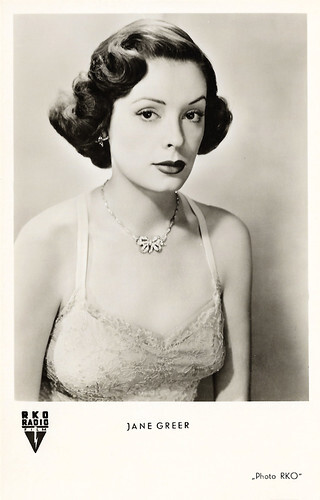
West German postcard by Kunst und Bild, Berlin, no. V 311. Photo: R.K.O. Radio. Jane Greer in The Big Steal (Don Siegel, 1949).
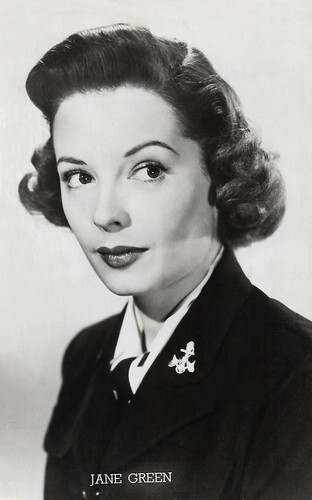
Belgian postcard, no. 252. Photo: 20th Century Fox. Jane Greer (not Green) in You're in the Navy Now (Henry Hathaway, 1951).
Sources: Ronald Bergan (The Guardian), (IMDb), Wikipedia (Dutch, German and English), and .

British postcard in the Picturegoer Series, London no. W. 686. Photo: R.K.O. Radio.
The golden cage of Howard Hughes
Bette Jane Greer was born in Washington, D.C., in 1924. She was the daughter of Charles Durell McClellan Greer Jr. and his wife, Bettie, who wrote children's stories. As a baby, ‘Bettejane’ already won a beauty contest and from her teenage years, she worked as a model for furs. At 15, she suffered facial paralysis and she later claimed that it was the subsequent therapeutic exercises that enabled her to express herself as an actress.
Thanks to her good looks and her attractive contralto voice she first started a career as a singer. She dropped out of her senior year at high school to work as a vocalist in a nightclub. She mostly sang for Enric Madriguera's orchestra at the Latin Club Del Rio in Washington, D.C. and sang phonetically in Spanish. She also performed on the radio where she met singer, entertainer, actor and bandleader Rudy Vallee.
In 1942, Bettejane appeared on the cover of Life magazine modelling army uniforms for women. The eccentric billionaire Howard Hughes reportedly noticed the 18-year-old and gave her a contract with RKO Pictures. Hughes managed to keep Greer under a kind of house arrest for five months. "Hughes was obsessed with me," she said many years later. "But at first it seemed as if he were offering me a superb career opportunity." She flew the obsessed Hughes and quickly married Rudy Vallee in 1943. An enraged Hughes pressured her and ruined the marriage. The couple separated after three months and divorced in 1944.
She returned to Hughes and her contract. At first, RKO gave her bit parts as showgirls in three films under her real name Bettejane Greer. She made her uncredited film debut in the romantic comedy Pan-Americana (John H. Auer, 1945). In 1945, Greer had her name legally changed to Jane Greer by a court in Los Angeles. She had bigger roles in the Film Noir Two O'Clock Courage (Anthony Mann, 1945) and Dick Tracy (William Berke, 1945), starring Russ Conway. This was a film adaptation of the Dick Tracy comic strip created by Chester Gould. It was the first of four instalments of the Dick Tracy film series, released by RKO Radio Pictures.
Greer had her breakthrough as femme fatale Kathie Moffat in the now classic Film Noir Out of the Past (Jacques Tourneur, 1947). Ronald Bergan in The Guardian: “She came into her own as one of the great two-timing dames in Jacques Tourneur's superb film noir Out of The Past, a part that was enough to make her one of the icons of the genre. As the femme fatale who coldly seduces Robert Mitchum in his first starring role, Greer changes character expertly to suit her particular needs, remote one moment, charming the next.” Greer co-starred with Robert Young and Susan Hayward in the Film Noir They Won't Believe Me (Irving Pichel, 1947), produced by Alfred Hitchcock 's longtime assistant and collaborator, Joan Harrison.

British postcard in the Picturegoer Series, London, no. D. 249. Photo: Metro-Goldwyn-Mayer. James Mason and Jane Greer in The Prisoner of Zenda (Richard Thorpe, 1952).

British postcard in the Picturegoer Series, London, no. D. 250. Photo: Metro-Goldwyn-Mayer. James Mason , Robert Douglas and Jane Greer in The Prisoner of Zenda (Richard Thorpe, 1952).
As long as I own the studio, you won't work
In 1947, Jane Greer married the lawyer and businessman Edward Lasker with whom she had three children. Even though Greer was now married, Hughes, in a noirish twist of fate, had just bought RKO, and was still interested in her romantically, writes Ronald Bergan. When Greer resisted him, Hughes barked out, "As long as I own the studio, you won't work." However, he relented and cast her to co-star once again with starred alongside Robert Mitchum , in another Film Noir, the fast-paced The Big Steal (Don Siegel, 1949).
Greer's last film for RKO was The Company She Keeps (1950) as a deceitful ex-con, making a play for the boyfriend of her parole officer ( Lizabeth Scott ). In one scene, the baby in her arms is Jeff Bridges , making his screen debut. At MGM, she appeared in the war comedy You're in the Navy Now (Henry Hathaway, 1951) opposite Gary Cooper .
In 1952, Greer co-starred in one of her best-known films, the Swashbuckler The Prisoner of Zenda (Richard Thorpe, 1952). Opposite Stewart Granger and James Mason , she was great as the plotting Antoinette de Mauban. In 1953, Greer largely withdrew from the film business for her family life. In the following decades, she only took on roles sporadically. Most were guest appearances in television series.
In the cinema, she co-starred with James Cagney in the dark dramatic film Man of a Thousand Faces (Joseph Pevney, 1957) detailing the life of silent film actor Lon Chaney . She played the second wife of Chaney. In 1984, she played the role of Kathie Moffat (Rachel Ward)'s mother, Jessie Wyler, in Against All Odds (Taylor Hackford, 1984), the remake of Out of the Past (1947). One of her last roles was that of the restaurant critic and failed actress Vivian Smythe Niles in David Lynch's mystery series Twin Peaks (1990).
In 2001, Jane Greer died of cancer at the age of 76 in Los Angeles and was buried in Westwood Village Memorial Park Cemetery in Los Angeles. For her contribution to cinema, a star was dedicated to her on the Hollywood Boulevard Walk of Fame. She divorced Edward Lasker in 1963. From 1965, she was the companion of actor and dialogue coach Frank London until he died in 2001, six months before Greer died. Jane Greer was the mother, with Edward Lasker, of Alex Lasker, Steven Lasker, and Lawrence Lasker. Lawrence Lasker was twice nominated for an Oscar - as the producer of Awakenings (Penny Marshall, 2001) and as the screenwriter of WarGames (John Badham, 1983). His brother Alex Lasker is also active in the film industry and is known as the screenwriter of such films as Firefox (Clint Eastwood, 1982), Beyond Rangoon (John Boorman, 1995) and Tears of the Sun (Antoine Fuqua, 2003).

West German postcard by Kunst und Bild, Berlin, no. V 311. Photo: R.K.O. Radio. Jane Greer in The Big Steal (Don Siegel, 1949).

Belgian postcard, no. 252. Photo: 20th Century Fox. Jane Greer (not Green) in You're in the Navy Now (Henry Hathaway, 1951).
Sources: Ronald Bergan (The Guardian), (IMDb), Wikipedia (Dutch, German and English), and .
Published on October 26, 2024 23:00
October 25, 2024
Franco Interlenghi
Italian actor Franco Interlenghi (1930-2015) was a popular leading man during the 1950s and worked with major directors like De Sica, Fellini, Antonioni, Bolognini and Rossellini. Although Interlenghi never gained international stardom, he was just as revered in his country as Marcello Mastroianni.
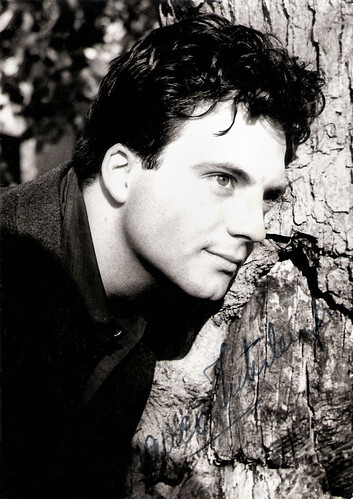
Italian autograph card. Signed in 1958.
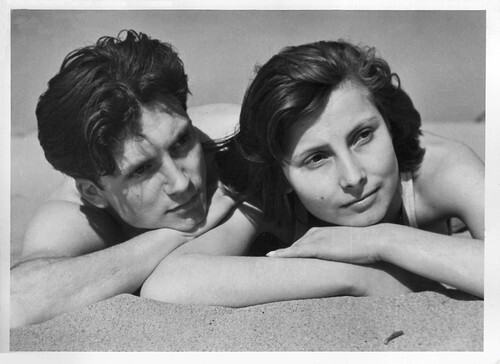
Vintage photo. Anna Baldini and Franco Interlenghi in Domenica d'agosto/A Sunday in August (Luciano Emmer, 1950).
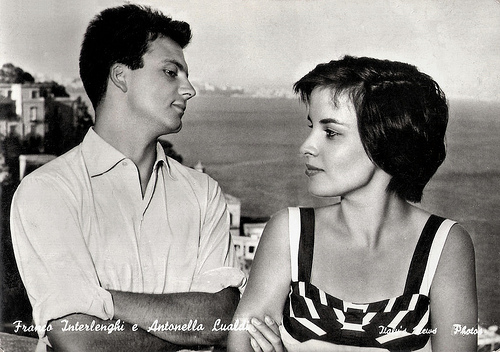
With Antonella Lualdi . Italian postcard by Bromofoto, Milano, no. 1234. Photo: Italy's News Photos.
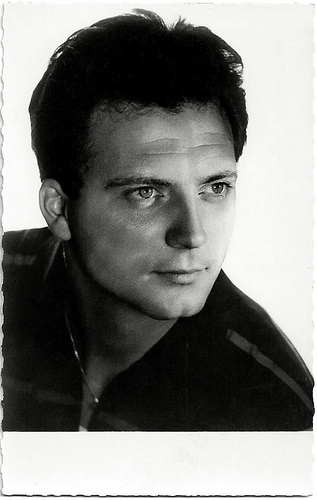
French postcard. Photo: Sam Lévin.
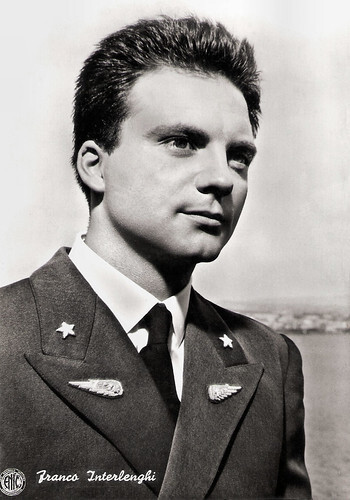
Italian postcard by Bromofoto, Milano, no. 1119. Photo: ENIC. Franco Interlenghi in Altair (Leonardo De Mitri, 1956).
Shoeshine
Franco Interlenghi was born in Rome, Italy in 1931 (some sources say 1930). At 15 years old, he made his film debut in a classic of the Italian neorealist cinema, Sciuscià/Shoeshine (Vittorio De Sica, 1946). De Sica used nonprofessional actors, and he painted an uncompromising picture of the lives of Italian street children abandoned by their parents at the end of World War II.
Sciuscià/Shoeshine (Vittorio De Sica, 1946) concentrates on two such children, Giuseppe (Rinaldo Smerdoni) and Pasquale (Franco Interlenghi). With no one else to turn to, the boys form a solid friendship, as well as a ‘corporation’ of sorts: they eke out a living shining the boots of American GIs.
In an interesting article unfortunately removed by AllMovie , Hal Erickson called Sciuscià 'a must-see example of Italian neorealist cinema': "A failure in Italy (director Vittorio De Sica noted that postwar Italian audiences preferred the glossy escapism emanating from Hollywood), Shoeshine was a huge success worldwide, as well as the winner of a special Academy Award. Like Bicycle Thieves, it combines De Sica's frequent focus on children with his emphasis on post-war social problems."
In the following years, young Franco appeared in more successful films like the historical epic Fabiola (Alessandro Blasetti, 1949) starring Michèle Morgan , and the neorealist comedy Domenica d'agosto/A Sunday in August (Luciano Emmer, 1950).
He played the son of Communist mayor Peppone ( Gino Cervi ) in the comedy classic Don Camillo/The Little World of Don Camillo (Julien Duvivier, 1952) featuring Fernandel . Other films in which he appeared were the murder drama Processo alla città/The City Stands Trial (Luigi Zampa, 1952), and the Homer adaptation Ulisse/Ulysses (Mario Camerini, 1954) starring Kirk Douglas and Silvana Mangano .
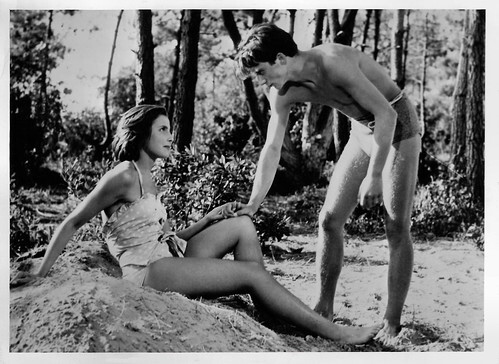
Vintage photo. Anna Baldini and Franco Interlenghi in Domenica d'agosto/A Sunday in August (Luciano Emmer, 1950).
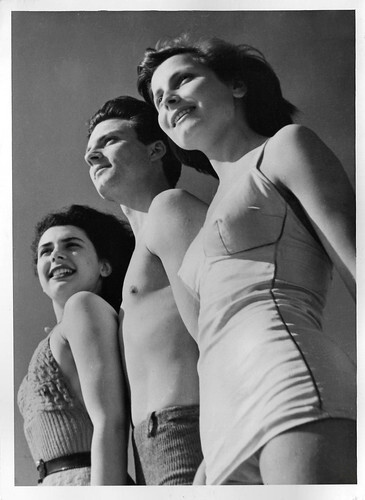
Vintage photo. Anna Baldini and Franco Interlenghi in Domenica d'agosto/A Sunday in August (Luciano Emmer, 1950).
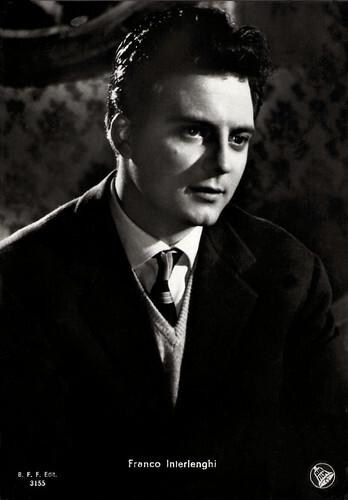
Italian postcard by Casa Edite. Ballerini & Fratini, Firenze, no. 3155. Photo: Dear Film.
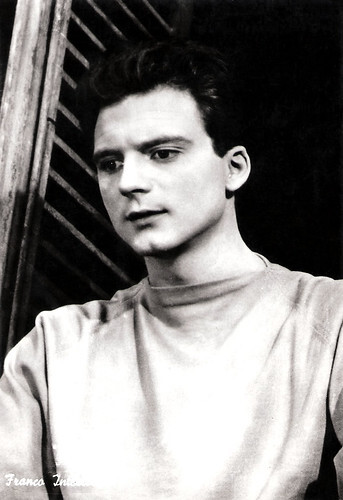
Italian postcard in the Divi del Cinema series by Vetta Traldi, Milano, no. 70.
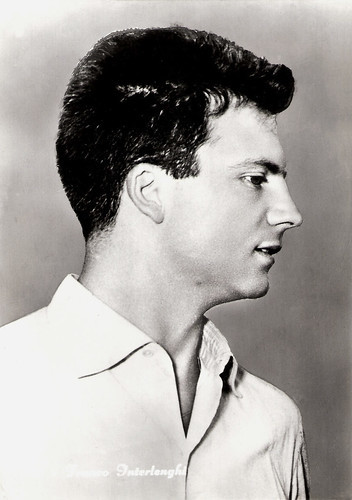
Italian postcard by Turismofoto.
Layabouts
Franco Interlenghi is probably best remembered for his leading role in Federico Fellini ’s beautiful I Vitelloni/Spivs (1953). I Vitelloni follows the lives of five young vitelloni, or layabouts, who while away their listless days in a small seaside village. While the film seems to pay little attention to Moraldo (Interlenghi), he eventually emerges as its key character, plainly serving as Fellini's alter ego.
Franco Interlenghi worked that same year with another maestro, Michelangelo Antonioni, at I Vinti/The Vanquished (1953), a triptych film featuring three murders in London, Paris and Rome.
Interlenghi appeared in supporting parts in several Hollywood productions filmed on location in Italy, like Teresa (Fred Zinnemann, 1951) with Pier Angeli , The Barefoot Contessa (Joseph L. Mankiewicz, 1954) starring Ava Gardner and Humphrey Bogart , and A Farewell to Arms( Charles Vidor, who replaced John Huston, 1957) with Rock Hudson .
In France, he starred opposite Brigitte Bardot and Jean Gabin in En Cas de malheur/Love is My Profession (Claude Autant-Lara, 1958).
Among his well-known Italian films of the 1950s were also Gli Innamorati/Wild Love (Mauro Bolognini, 1955) with his wife Antonella Lualdi , the comedy Totò, Peppino e i... fuorilegge/Totò, Peppino and the Outlaw (Camillo Mastrocinque, 1956) starring comedians Totò and Peppino de Filippo , the comedy Padri e figli/Like Father, Like Son (Mario Monicelli, 1957), the war drama Il generale della Rovere/General della Rovere (Roberto Rossellini, 1959) featuring Vittorio De Sica , and the crime drama La notte brava/Bad Girls Don’t Cry (Mauro Bolognini, 1959), again opposite Antonella Lualdi .
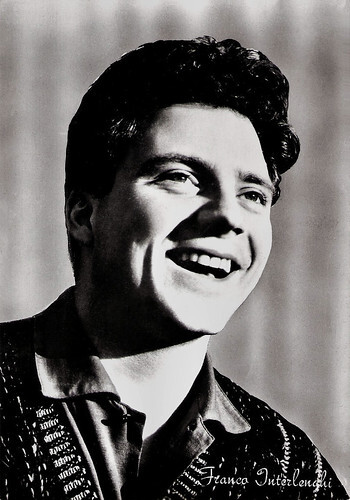
Italian postcard by Rotalfoto, Milano, no. 562.
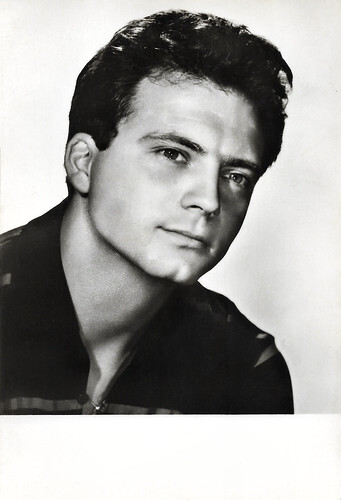
Italian postcard in the Hobby series by Bromostampa, Milano, no. L. 15.
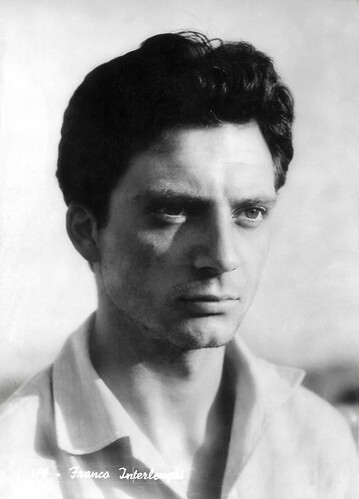
Italian postcard in the Divi del Cinema series by Vetta Traldi, Milano, no. 179.
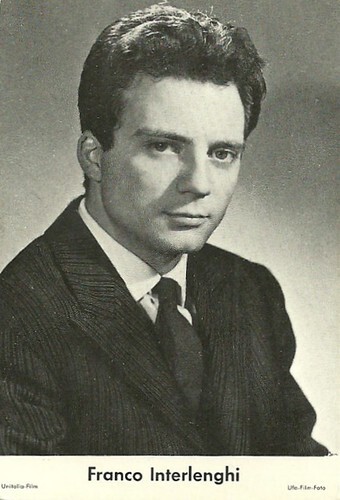
German minicard by Ufa-Film-Foto. Photo: Unitalia-Film.
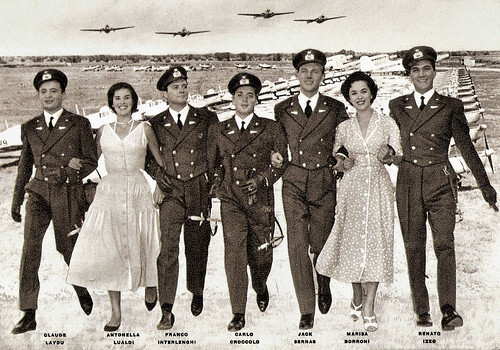
Italian postcard by La Rotografica Romana. Photo: Cines / ENIC. Claude Laydu, Antonella Lualdi , Franco Interlenghi, Jacques Sernas and others in Altair (Leonardo De Mitri, 1956).
Sexploitation
Although Franco Interlenghi would never gain international stardom, he was a popular film actor in his home country. In addition to films, he also appeared in successful theatrical productions. He worked with famous director Luchino Visconti on an adaptation of 'Death of a Salesman'.
In the 1960s and 1970s, he appeared less often in the cinema. His films from this period include the historical drama Viva l'Italia!/Garibaldi (Roberto Rossellini, 1961), the crime film Mise a Sac/Pillaged (Alain Cavalier, 1967), the historical romance Columna/The Column (Mircea Dragan, 1968), and the Western Amore, piombo e furore/China 9, Liberty 37 (Monte Hellmann, 1978) with Fabio Testi and Warren Oates.
In the following decades, he was seen more regularly in films and also on TV. His roles were however smaller and the films less successful than during the 1950s. He appeared in supporting parts in the crime drama Il Camorrista/The Professor (Giuseppe Tornatore, 1986) starring Ben Gazzara , the Molière adaptation L’avare/The Miser (Tonino Cervi, 1990) starring Alberto Sordi , the psychological thriller L’ours en peluche/The Teddybear (Jacques Deray, 1994) with Alain Delon , and the drama Marciando Nel Buio/Marching in the dark (Massimo Spano, 1995), about the brutal rape of a young soldier and his attempts to bring the culprit to justice. He also appeared in a sexploitation film by Tinto Brass, Miranda (Tinto Brass, 1985).
Later films were the sweeping crime drama Romanzo Criminale/Crime Novel (Michele Placido, 2005) starring Kim Rossi Stuart , and the comedy sequel Notte prima degli esami – Oggi/The Night Before the Exams - Today (Fausto Brizzi, 2007).
When he died in 2015, Franco Interlenghi was still married to Antonella Lualdi . He was 83. The couple married in 1955 and their marriage was one of the happiest in the Italian film community. Both their daughter, Antonellina Interlenghi and their granddaughter, Virginia Sanjust Di Teulada are actors too.
Trailer Sciuscià/Shoeshine (1946). Source: Umbrella Entertainment (YouTube).
I Vinti/The Vanquished (1953). Source: Film&Clips (YouTube).
Trailer I Vitelloni/Spivs (1953) with Alberto Sordi and Franco Interlenghi. Source: Umbgu (YouTube).
How to Knock a Kiss: Antonella Lualdi and Franco Interlenghi. A delightful clip by Mr. Rug Cutter with footage from Gli Innamorati (Mauro Bolognini, 1955) and music by Three Suns, 'Movin`N´Groovin'. Source: Mr. Rug Cutter (YouTube).
Sources: Hal Erickson (AllMovie - page now defunct), Sandra Brennan (AllMovie - page now defunct), Les gens du cinema (French), Wikipedia and .

Italian autograph card. Signed in 1958.

Vintage photo. Anna Baldini and Franco Interlenghi in Domenica d'agosto/A Sunday in August (Luciano Emmer, 1950).

With Antonella Lualdi . Italian postcard by Bromofoto, Milano, no. 1234. Photo: Italy's News Photos.

French postcard. Photo: Sam Lévin.

Italian postcard by Bromofoto, Milano, no. 1119. Photo: ENIC. Franco Interlenghi in Altair (Leonardo De Mitri, 1956).
Shoeshine
Franco Interlenghi was born in Rome, Italy in 1931 (some sources say 1930). At 15 years old, he made his film debut in a classic of the Italian neorealist cinema, Sciuscià/Shoeshine (Vittorio De Sica, 1946). De Sica used nonprofessional actors, and he painted an uncompromising picture of the lives of Italian street children abandoned by their parents at the end of World War II.
Sciuscià/Shoeshine (Vittorio De Sica, 1946) concentrates on two such children, Giuseppe (Rinaldo Smerdoni) and Pasquale (Franco Interlenghi). With no one else to turn to, the boys form a solid friendship, as well as a ‘corporation’ of sorts: they eke out a living shining the boots of American GIs.
In an interesting article unfortunately removed by AllMovie , Hal Erickson called Sciuscià 'a must-see example of Italian neorealist cinema': "A failure in Italy (director Vittorio De Sica noted that postwar Italian audiences preferred the glossy escapism emanating from Hollywood), Shoeshine was a huge success worldwide, as well as the winner of a special Academy Award. Like Bicycle Thieves, it combines De Sica's frequent focus on children with his emphasis on post-war social problems."
In the following years, young Franco appeared in more successful films like the historical epic Fabiola (Alessandro Blasetti, 1949) starring Michèle Morgan , and the neorealist comedy Domenica d'agosto/A Sunday in August (Luciano Emmer, 1950).
He played the son of Communist mayor Peppone ( Gino Cervi ) in the comedy classic Don Camillo/The Little World of Don Camillo (Julien Duvivier, 1952) featuring Fernandel . Other films in which he appeared were the murder drama Processo alla città/The City Stands Trial (Luigi Zampa, 1952), and the Homer adaptation Ulisse/Ulysses (Mario Camerini, 1954) starring Kirk Douglas and Silvana Mangano .

Vintage photo. Anna Baldini and Franco Interlenghi in Domenica d'agosto/A Sunday in August (Luciano Emmer, 1950).

Vintage photo. Anna Baldini and Franco Interlenghi in Domenica d'agosto/A Sunday in August (Luciano Emmer, 1950).

Italian postcard by Casa Edite. Ballerini & Fratini, Firenze, no. 3155. Photo: Dear Film.

Italian postcard in the Divi del Cinema series by Vetta Traldi, Milano, no. 70.

Italian postcard by Turismofoto.
Layabouts
Franco Interlenghi is probably best remembered for his leading role in Federico Fellini ’s beautiful I Vitelloni/Spivs (1953). I Vitelloni follows the lives of five young vitelloni, or layabouts, who while away their listless days in a small seaside village. While the film seems to pay little attention to Moraldo (Interlenghi), he eventually emerges as its key character, plainly serving as Fellini's alter ego.
Franco Interlenghi worked that same year with another maestro, Michelangelo Antonioni, at I Vinti/The Vanquished (1953), a triptych film featuring three murders in London, Paris and Rome.
Interlenghi appeared in supporting parts in several Hollywood productions filmed on location in Italy, like Teresa (Fred Zinnemann, 1951) with Pier Angeli , The Barefoot Contessa (Joseph L. Mankiewicz, 1954) starring Ava Gardner and Humphrey Bogart , and A Farewell to Arms( Charles Vidor, who replaced John Huston, 1957) with Rock Hudson .
In France, he starred opposite Brigitte Bardot and Jean Gabin in En Cas de malheur/Love is My Profession (Claude Autant-Lara, 1958).
Among his well-known Italian films of the 1950s were also Gli Innamorati/Wild Love (Mauro Bolognini, 1955) with his wife Antonella Lualdi , the comedy Totò, Peppino e i... fuorilegge/Totò, Peppino and the Outlaw (Camillo Mastrocinque, 1956) starring comedians Totò and Peppino de Filippo , the comedy Padri e figli/Like Father, Like Son (Mario Monicelli, 1957), the war drama Il generale della Rovere/General della Rovere (Roberto Rossellini, 1959) featuring Vittorio De Sica , and the crime drama La notte brava/Bad Girls Don’t Cry (Mauro Bolognini, 1959), again opposite Antonella Lualdi .

Italian postcard by Rotalfoto, Milano, no. 562.

Italian postcard in the Hobby series by Bromostampa, Milano, no. L. 15.

Italian postcard in the Divi del Cinema series by Vetta Traldi, Milano, no. 179.

German minicard by Ufa-Film-Foto. Photo: Unitalia-Film.

Italian postcard by La Rotografica Romana. Photo: Cines / ENIC. Claude Laydu, Antonella Lualdi , Franco Interlenghi, Jacques Sernas and others in Altair (Leonardo De Mitri, 1956).
Sexploitation
Although Franco Interlenghi would never gain international stardom, he was a popular film actor in his home country. In addition to films, he also appeared in successful theatrical productions. He worked with famous director Luchino Visconti on an adaptation of 'Death of a Salesman'.
In the 1960s and 1970s, he appeared less often in the cinema. His films from this period include the historical drama Viva l'Italia!/Garibaldi (Roberto Rossellini, 1961), the crime film Mise a Sac/Pillaged (Alain Cavalier, 1967), the historical romance Columna/The Column (Mircea Dragan, 1968), and the Western Amore, piombo e furore/China 9, Liberty 37 (Monte Hellmann, 1978) with Fabio Testi and Warren Oates.
In the following decades, he was seen more regularly in films and also on TV. His roles were however smaller and the films less successful than during the 1950s. He appeared in supporting parts in the crime drama Il Camorrista/The Professor (Giuseppe Tornatore, 1986) starring Ben Gazzara , the Molière adaptation L’avare/The Miser (Tonino Cervi, 1990) starring Alberto Sordi , the psychological thriller L’ours en peluche/The Teddybear (Jacques Deray, 1994) with Alain Delon , and the drama Marciando Nel Buio/Marching in the dark (Massimo Spano, 1995), about the brutal rape of a young soldier and his attempts to bring the culprit to justice. He also appeared in a sexploitation film by Tinto Brass, Miranda (Tinto Brass, 1985).
Later films were the sweeping crime drama Romanzo Criminale/Crime Novel (Michele Placido, 2005) starring Kim Rossi Stuart , and the comedy sequel Notte prima degli esami – Oggi/The Night Before the Exams - Today (Fausto Brizzi, 2007).
When he died in 2015, Franco Interlenghi was still married to Antonella Lualdi . He was 83. The couple married in 1955 and their marriage was one of the happiest in the Italian film community. Both their daughter, Antonellina Interlenghi and their granddaughter, Virginia Sanjust Di Teulada are actors too.
Trailer Sciuscià/Shoeshine (1946). Source: Umbrella Entertainment (YouTube).
I Vinti/The Vanquished (1953). Source: Film&Clips (YouTube).
Trailer I Vitelloni/Spivs (1953) with Alberto Sordi and Franco Interlenghi. Source: Umbgu (YouTube).
How to Knock a Kiss: Antonella Lualdi and Franco Interlenghi. A delightful clip by Mr. Rug Cutter with footage from Gli Innamorati (Mauro Bolognini, 1955) and music by Three Suns, 'Movin`N´Groovin'. Source: Mr. Rug Cutter (YouTube).
Sources: Hal Erickson (AllMovie - page now defunct), Sandra Brennan (AllMovie - page now defunct), Les gens du cinema (French), Wikipedia and .
Published on October 25, 2024 22:00
October 24, 2024
Erich Ponto
Erich Ponto (1884-1957) was a German film and stage actor. He became known as J.J. Peachum in Brecht’s ‘Dreigroschenoper ‘(Three Penny Opera). From the 1930s, he played supporting and leading parts in dozens of German films. He co-starred with Heinz Rühmann in the comedy Die Feuerzangenbowle/The Punch Bowl (1944), a classic of German cinema and a cult film among German students.
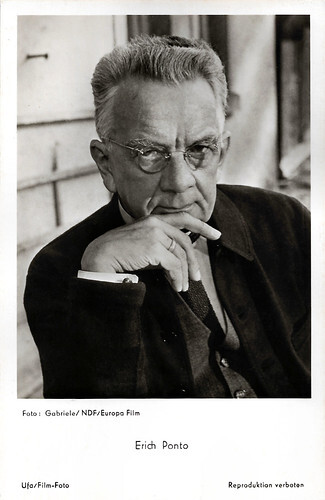
West German postcard by Ufa/Film-Foto, Berlin-Tempelhof, no. FK 1937. Photo: Gabriela / NDF / Europa Film. Erich Ponto in Himmel ohne Sterne/Sky Without Stars (Helmut Käutner, 1955).
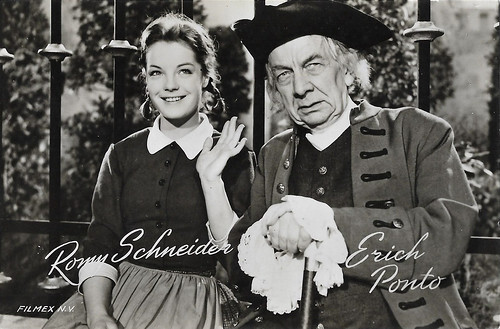
Dutch postcard. Filmex N.V. Romy Schneider as Maud and Erich Ponto as the writer Daniel Dafoe in Robinson soll nicht sterben/The Legend of Robinson Crusoe (Josef von Báky, 1957). The Dutch title was 'Droomeiland' (Island of Dreams).
The Threepenny Opera
Erich Johannes Bruno Ponto was born in Lübeck in 1884. He was the youngest of four children of a textile merchant, Heinrich Ludwig Ponto and his wife Ida, née Albers. They initially lived in Lübeck and later moved to Hamburg-Eimsbüttel.
Erich Ponto attended school in Altona. He studied pharmacy at the University of Munich and attended lectures delivered by physicist Wilhelm Röntgen. His discovery of X-rays or Röntgen rays, had earned him the inaugural Nobel Prize in Physics in 1901. Ponto worked for a few years as a pharmacist but was already passionate about acting during his university time.
He started to take acting lessons and eventually became a full-time actor. Ponto made his stage debut at the Stadttheater Passau in 1908. It was followed by engagements in Nordhausen, Reichenberg (Liberec), and Düsseldorf. From 1914 to 1947 he was a member of the Hoftheater Dresden ensemble (Staatstheater Dresden from 1918). In the season 1946/47 he also worked there as an intendant.
In 1920, Ponto made his first film appearance in the short film Hampelmanns Glückstag/Hampelmann's Lucky Day (N.N., 1920), which was followed by Der Geiger von Meißen/The Fiddler of Meissen (Ferdinand Roberti, 1921). However, Ponto's cinema career only began with the sound film at the end of the 1920s.
On stage, his most famous role was that of J.J. Peachum in the original production of Bertolt Brecht's 'Dreigroschenoper’ (The Threepenny Opera) in 1928. During the Third Reich, he won the title of Staatsschauspieler in 1938, the highest title that could be awarded to a stage actor in Nazi Germany. Later stage roles included 'Nathan the Wise' in 1945 and Willy Loman in 'Death of a Salesman' in 1950.
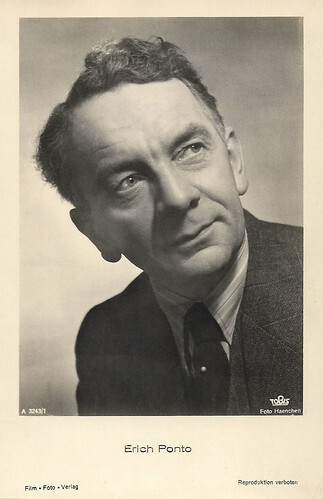
German postcard by Film-Foto-Verlag, no. A 3243/1, 1941-1944. Photo: Haenchen / Tobis.
A nostalgic reminder of a lost past
Erich Ponto only started to appear in films regularly after the start of the sound film, when he was already middle-aged. He had a starring role in the Paramount drama Weib im Dschungel/Woman in the Jungle (Dimitri Buchowetzki, 1931) opposite Charlotte Ander and Ernst Stahl-Nachbaur. The drama set in British Malaya was shot at the Joinville Studios in Paris as the German-language version of The Letter (Jean de Limur, 1929), based on the 1927 play 'The Letter' by W. Somerset Maugham.
Such multiple-language versions were common during the early years of sound before dubbing became widespread. He played supporting parts in the German crime drama Der Mann, der den Mord beging/The Man Who Murdered (Kurt a.k.a. Curtis Bernhardt, 1931) starring Conrad Veidt , and the melodrama Schlußakkord/Final Accord (1936) with Lil Dagover . It was the first melodrama directed by Detlef Sierck, who later as Douglas Sirk became the grand master of melodrama in Hollywood.
Ponto became a well-known character actor in German cinema in the 1930s and 1940s. He often played eccentric or villainous roles. Ponto played the title role in the historical comedy Schneider Wibbel/Wibbel the Tailor (Viktor de Kowa, 1939) co-starring Fita Benkhoff and Irene von Meyendorff . He appeared as Mayor Amschel Rothschild in the antisemitic Nazi film Die Rothschilds/The Rothschilds (Erich Waschneck, 1940).
He also played a stuffy school teacher in Die Feuerzangenbowle/The Punch Bowl (Heinz Weiss, 1944) with Heinz Rühmann . Rühmann’s transformation of the accomplished writer back to a not-so-innocent schoolboy is an example of the cheerful escapism popular in German films at the end of World War II. In 1942, propaganda minister Joseph Goebbels called for the production of predominantly entertaining films in Germany to distract the population from the political and moral debacle of the war.
The charm of the teachers in Die Feuerzangenbowle/The Punch Bowl lies in their old-fashioned attitudes and individual quirks. As representatives of an older, non-fascist generation, they were a nostalgic reminder of a lost past to the wartime generation in Germany. The film ridicules and at the same time celebrates this lost individuality through parody. Since the 1980s, the film has gained cult film status at many German universities. During party-like showings in university auditoriums in early December, thousands of students bring props to participate in the film's action similar to audience participation in showings of The Rocky Horror Picture Show (Jim Sharman, 1975).
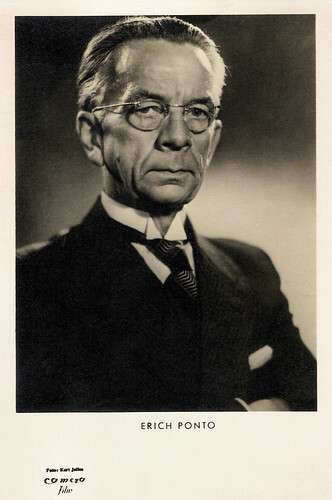
German postcard by Photo-Kitt, München, no. 518. Photo: Camera Film / Kurt Julius. Erich Ponto in Film ohne titel/Film Without Title (Rudolf Jugert, 1948).
The Molander Case
When Erich Ponto’s house was searched during the Nazi era, original drawings by Käthe Kollwitz, who was frowned upon by the regime, were confiscated. Ponto claimed that he needed them for his work and so they remained in his possession. In 1944, Ponto was included in the Reich Ministry of Propaganda's list of so-called ‘Gottbegnadeten.
He appeared in the mysterious film Der Fall Molander/The Molander Case (1945) by Georg Wilhelm Pabst. In 1944, Pabst started shooting the film for Terra. As shooting was just completed at the Barrandov Studios in Prague, and the process of editing began, Prague was liberated by the Red Army and Pabst was forced to abandon the work. The remaining film is kept at the Národní Filmový Archiv in Prague.
After World War II, Erich Ponto had a supporting part in the drama Zwischen gestern und morgen/Between Yesterday and Tomorrow (Harald Braun, 1947) starring Hildegard Knef , Winnie Markus and Sybille Schmitz . It was part of the cycle of rubble films and examines issues of collective guilt and future rebuilding.
He then appeared in a supporting role in the classic British thriller The Third Man (Carol Reed, 1949), playing a sinister physician. He played the lead in the dark drama Schicksal aus zweiter Hand/Second Hand Destiny (Wolfgang Staudte 1949) with Marianne Hoppe . Very successful was the family comedy Das fliegende Klassenzimmer/The Flying Classroom (Kurt Hoffmann, 1954) starring Paul Dahlke, Heliane Bei and Paul Klinger . It is an adaptation of Erich Kästner’s novel ‘The Flying Classroom’(1933). In 1955 Ponto won the German Film Award as the Best Male Actor in a Supporting Role for Himmel ohne Sterne/Sky Without Stars (Helmut Käutner, 1955) starring Erik Schumann and Horst Buchholz .
With Romy Schneider and Buchholz, he acted in the historical drama Robinson soll nicht sterben/The Girl and the Legend (Josef von Báky,1957). As a synchronisation actor, Ponto dubbed English-language actors like Lionel Barrymore , Charles Laughton and Charley Grapewin in several films between the mid-1930s and early 1950s. He worked as an actor until shortly before his death. In 1916 he married Tony Kresse, and they had two children. Ponto also worked as an acting teacher, among his students was Gert Fröbe. Ponto's final film was Der Stern von Afrika/The Star of Africa (Alfred Weidenmann, 1957) starring Joachim Hansen . Erich Ponto died at the age of 72 after a long cancerous illness. He was the uncle of Dresdner Bank general director Jürgen Ponto, who was murdered by the RAF in 1977.
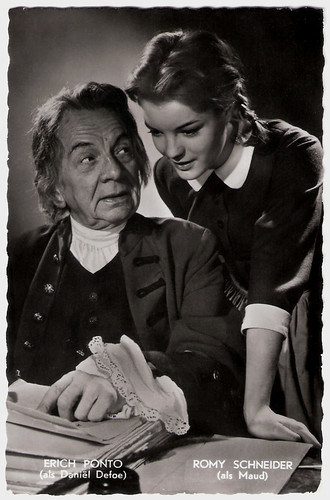
Dutch postcard by Int. Filmpers (IFP), Amsterdam, no. 1091. Erich Ponto as Daniël Defoe, author of Robinson Crusoe, and Romy Schneider as Maud in Robinson soll nicht sterben/The Legend of Robinson Crusoe (Josef von Báky, 1957).
Sources: Wikipedia (German and English) and .

West German postcard by Ufa/Film-Foto, Berlin-Tempelhof, no. FK 1937. Photo: Gabriela / NDF / Europa Film. Erich Ponto in Himmel ohne Sterne/Sky Without Stars (Helmut Käutner, 1955).

Dutch postcard. Filmex N.V. Romy Schneider as Maud and Erich Ponto as the writer Daniel Dafoe in Robinson soll nicht sterben/The Legend of Robinson Crusoe (Josef von Báky, 1957). The Dutch title was 'Droomeiland' (Island of Dreams).
The Threepenny Opera
Erich Johannes Bruno Ponto was born in Lübeck in 1884. He was the youngest of four children of a textile merchant, Heinrich Ludwig Ponto and his wife Ida, née Albers. They initially lived in Lübeck and later moved to Hamburg-Eimsbüttel.
Erich Ponto attended school in Altona. He studied pharmacy at the University of Munich and attended lectures delivered by physicist Wilhelm Röntgen. His discovery of X-rays or Röntgen rays, had earned him the inaugural Nobel Prize in Physics in 1901. Ponto worked for a few years as a pharmacist but was already passionate about acting during his university time.
He started to take acting lessons and eventually became a full-time actor. Ponto made his stage debut at the Stadttheater Passau in 1908. It was followed by engagements in Nordhausen, Reichenberg (Liberec), and Düsseldorf. From 1914 to 1947 he was a member of the Hoftheater Dresden ensemble (Staatstheater Dresden from 1918). In the season 1946/47 he also worked there as an intendant.
In 1920, Ponto made his first film appearance in the short film Hampelmanns Glückstag/Hampelmann's Lucky Day (N.N., 1920), which was followed by Der Geiger von Meißen/The Fiddler of Meissen (Ferdinand Roberti, 1921). However, Ponto's cinema career only began with the sound film at the end of the 1920s.
On stage, his most famous role was that of J.J. Peachum in the original production of Bertolt Brecht's 'Dreigroschenoper’ (The Threepenny Opera) in 1928. During the Third Reich, he won the title of Staatsschauspieler in 1938, the highest title that could be awarded to a stage actor in Nazi Germany. Later stage roles included 'Nathan the Wise' in 1945 and Willy Loman in 'Death of a Salesman' in 1950.

German postcard by Film-Foto-Verlag, no. A 3243/1, 1941-1944. Photo: Haenchen / Tobis.
A nostalgic reminder of a lost past
Erich Ponto only started to appear in films regularly after the start of the sound film, when he was already middle-aged. He had a starring role in the Paramount drama Weib im Dschungel/Woman in the Jungle (Dimitri Buchowetzki, 1931) opposite Charlotte Ander and Ernst Stahl-Nachbaur. The drama set in British Malaya was shot at the Joinville Studios in Paris as the German-language version of The Letter (Jean de Limur, 1929), based on the 1927 play 'The Letter' by W. Somerset Maugham.
Such multiple-language versions were common during the early years of sound before dubbing became widespread. He played supporting parts in the German crime drama Der Mann, der den Mord beging/The Man Who Murdered (Kurt a.k.a. Curtis Bernhardt, 1931) starring Conrad Veidt , and the melodrama Schlußakkord/Final Accord (1936) with Lil Dagover . It was the first melodrama directed by Detlef Sierck, who later as Douglas Sirk became the grand master of melodrama in Hollywood.
Ponto became a well-known character actor in German cinema in the 1930s and 1940s. He often played eccentric or villainous roles. Ponto played the title role in the historical comedy Schneider Wibbel/Wibbel the Tailor (Viktor de Kowa, 1939) co-starring Fita Benkhoff and Irene von Meyendorff . He appeared as Mayor Amschel Rothschild in the antisemitic Nazi film Die Rothschilds/The Rothschilds (Erich Waschneck, 1940).
He also played a stuffy school teacher in Die Feuerzangenbowle/The Punch Bowl (Heinz Weiss, 1944) with Heinz Rühmann . Rühmann’s transformation of the accomplished writer back to a not-so-innocent schoolboy is an example of the cheerful escapism popular in German films at the end of World War II. In 1942, propaganda minister Joseph Goebbels called for the production of predominantly entertaining films in Germany to distract the population from the political and moral debacle of the war.
The charm of the teachers in Die Feuerzangenbowle/The Punch Bowl lies in their old-fashioned attitudes and individual quirks. As representatives of an older, non-fascist generation, they were a nostalgic reminder of a lost past to the wartime generation in Germany. The film ridicules and at the same time celebrates this lost individuality through parody. Since the 1980s, the film has gained cult film status at many German universities. During party-like showings in university auditoriums in early December, thousands of students bring props to participate in the film's action similar to audience participation in showings of The Rocky Horror Picture Show (Jim Sharman, 1975).

German postcard by Photo-Kitt, München, no. 518. Photo: Camera Film / Kurt Julius. Erich Ponto in Film ohne titel/Film Without Title (Rudolf Jugert, 1948).
The Molander Case
When Erich Ponto’s house was searched during the Nazi era, original drawings by Käthe Kollwitz, who was frowned upon by the regime, were confiscated. Ponto claimed that he needed them for his work and so they remained in his possession. In 1944, Ponto was included in the Reich Ministry of Propaganda's list of so-called ‘Gottbegnadeten.
He appeared in the mysterious film Der Fall Molander/The Molander Case (1945) by Georg Wilhelm Pabst. In 1944, Pabst started shooting the film for Terra. As shooting was just completed at the Barrandov Studios in Prague, and the process of editing began, Prague was liberated by the Red Army and Pabst was forced to abandon the work. The remaining film is kept at the Národní Filmový Archiv in Prague.
After World War II, Erich Ponto had a supporting part in the drama Zwischen gestern und morgen/Between Yesterday and Tomorrow (Harald Braun, 1947) starring Hildegard Knef , Winnie Markus and Sybille Schmitz . It was part of the cycle of rubble films and examines issues of collective guilt and future rebuilding.
He then appeared in a supporting role in the classic British thriller The Third Man (Carol Reed, 1949), playing a sinister physician. He played the lead in the dark drama Schicksal aus zweiter Hand/Second Hand Destiny (Wolfgang Staudte 1949) with Marianne Hoppe . Very successful was the family comedy Das fliegende Klassenzimmer/The Flying Classroom (Kurt Hoffmann, 1954) starring Paul Dahlke, Heliane Bei and Paul Klinger . It is an adaptation of Erich Kästner’s novel ‘The Flying Classroom’(1933). In 1955 Ponto won the German Film Award as the Best Male Actor in a Supporting Role for Himmel ohne Sterne/Sky Without Stars (Helmut Käutner, 1955) starring Erik Schumann and Horst Buchholz .
With Romy Schneider and Buchholz, he acted in the historical drama Robinson soll nicht sterben/The Girl and the Legend (Josef von Báky,1957). As a synchronisation actor, Ponto dubbed English-language actors like Lionel Barrymore , Charles Laughton and Charley Grapewin in several films between the mid-1930s and early 1950s. He worked as an actor until shortly before his death. In 1916 he married Tony Kresse, and they had two children. Ponto also worked as an acting teacher, among his students was Gert Fröbe. Ponto's final film was Der Stern von Afrika/The Star of Africa (Alfred Weidenmann, 1957) starring Joachim Hansen . Erich Ponto died at the age of 72 after a long cancerous illness. He was the uncle of Dresdner Bank general director Jürgen Ponto, who was murdered by the RAF in 1977.

Dutch postcard by Int. Filmpers (IFP), Amsterdam, no. 1091. Erich Ponto as Daniël Defoe, author of Robinson Crusoe, and Romy Schneider as Maud in Robinson soll nicht sterben/The Legend of Robinson Crusoe (Josef von Báky, 1957).
Sources: Wikipedia (German and English) and .
Published on October 24, 2024 22:00
October 23, 2024
Madeleine Roch
Madeleine Roch (1883–1930) was a famous French 'tragédienne' from the Comédie Française. Between 1909 and 1911, she acted in a series of 11 Film d'Art-like historical films mostly at Pathé Frères but also one at Gaumont.
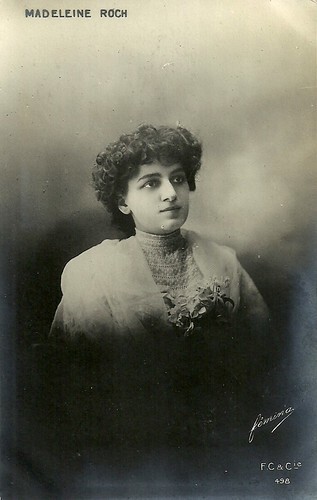
French postcard by F.C. & Cie, no. 498. Photo: Fémina.
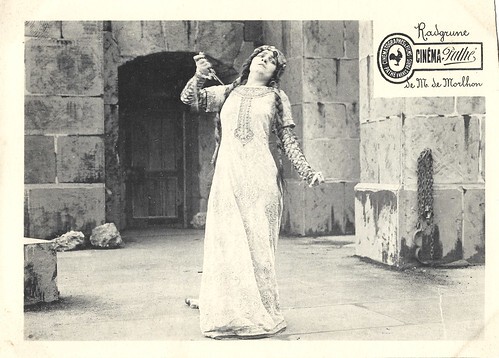
Big photocard by Cinéma Pathé / Pathé Frères. Photo: S.A.P.F. Madeleine Roch as the title character in the historical drama Radgrune (Camille de Morlhon, 1911).
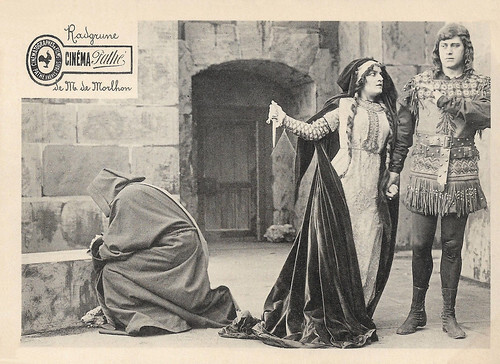
Big photo card by Cinéma Pathé / Pathé Frères. Photo: S.A.P.F. Madeleine Roch as the title character in the historical drama Radgrune (Camille de Morlhon, 1911). Right of her, René Alexandre as the young prince.
11 Film d'Art-like historical films
Julienne Madeleine Roch was born in 1883 in Les Mureaux, Yvelines, France. She entered the the Conservatoire national de musique et de déclamation in Paris in 1901 and attended the class of Silvani. She graduated the following year with a first prize for tragedy, playing the role of Roxane in Racine's 'Bajazet'. She entered the Comédie-Française in 1903 at the age of 20 and was Sociétaire (a member) between 1912 and 1930.
Between 1909 and 1911, Madeleine Roch acted in a series of 11 Film d'Art-like historical films. Most of these short silent films she made at Pathé Frères, but at Gaumont, she appeared in Esther (1910) by Louis Feuillade .
She made her film debut as Katusha, a country girl, who is seduced and abandoned by Prince Nekludov in the Lev Tolstoy adaptation Résurrection (André Calmettes, Henri Desfontaines, 1909). Henri Andréani directed her in Messaline (Ferdinand Zecca, Henri Andréani, 1910), Cléopâtre/Cleopatra (Ferdinand Zecca, Henri Andréani, 1910), and Moïse sauvé des eaux/Moses Saved from the Waters (Henri Andréani, 1911).
Camille de Morlhon directed her in Une intrigue à la cour d’Henry VIII/Anne Boleyn (Camille de Morlhon, 1911) and Radgrune (Camille de Morlhon, 1911). De Morlhon also scripted Radgrune. The plot deals with the rivalry between two powerful princes, Ildacre and Odobert (Louis Ravet). Odobert had a convoy headed for the neighbouring castle seized by an armed force. In revenge, Ildacre, at the instigation of his daughter Radgrune, abducts the son of Prince Odobert ( René Alexandre ). A dancer seduces the son and delivers him to Ildacre.
However, Radgrune falls in love with the prince whose death she wanted. She begs her father in vain to pardon her prisoner. Unable to bend his anger, she frees the young prince, having exchanged his clothes for hers. Left alone, the young girl, fearing her father's anger, prefers death and plunges a dagger into her heart, happy to sacrifice her life for the one she loves.
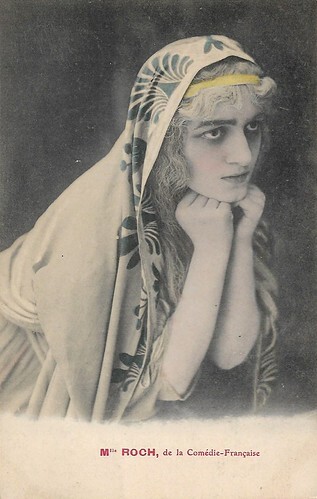
French postcard. Madeleine Roch was the nurse in the play 'Médée' by Catulle Mendès, performed at the Comédie Française, Paris in July 1903.
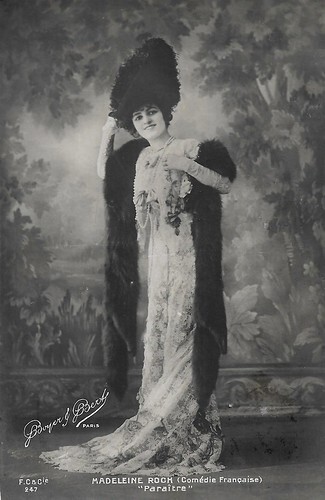
French postcard by F.C. & Cie, no. 247. Photo: Boyer and Bert. Madeleine Roch as Mme Hurtz in 'Paraître' by Maurice Donnay, performed in 1906.
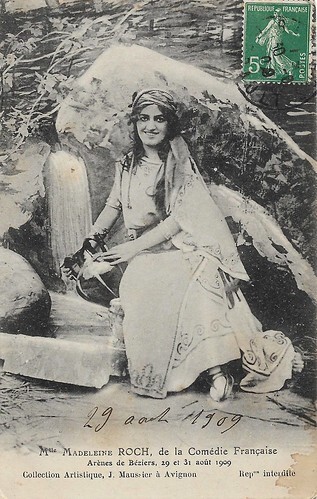
French postcard. Photo by J. Maussier, Avignon. Caption: Madeleine Roch de la Comédie Française. Possibly in 'La fille du soleil'. Arènes de Béziers, 29 and 31 August 1909.
Sociétaire of the Comédie-Française
Madeleine Roch quit film acting in 1912, probably because she became Sociétaire of the Comédie-Française. She performed in particular the plays of Jean Racine, such as 'Bajazet', 'Bérénice', 'Andromaque', 'Brittanicus', 'Iphigénie' and 'Phèdre'.
She also acted in plays by Corneille and in Greek tragedies such as Sophocles' 'Electra' and Euripides's 'Iphigenia'. Sometimes, she did sidesteps in comedy, such as 'Paraître' (1906) by Maurice Donnay. She was also one of the great interpreters of Victor Hugo . In 1914, she was invited to Guernsey for the inauguration of a monument to Hugo, designed by Jean Boucher.
At the open air Théâtre des Arènes in Béziers, she starred in 'Le premier glaive' (1908), 'La fille du soleil' (1909), 'Héliogabale' (1910), and 'Les esclaves' (1910). She also performed in open air theatre at Orange, Cauterets and Pau.
Madeleine Roch died in 1930 in Gaillon-sur-Montcient at the age of 47. A street in her hometown Les Mureaux was named after her. There she is buried in the local cemetery. A commemorative plaque has been placed on the promenade des Marronniers, the former Théâtre de la Nature in Lectoure, where she performed for the last time on 3 August 1930.
Some of her films have survived. A black-and-white version of Moïse sauvé des eaux (Henri Andréani, 1911) can be found on YouTube. Roch plays Moses' mother. YouTube also offers a copy of the modern film Femme fatale (1912), in which Roch plays the mother of the first victim of the femme fatale. Un intrigue à la cour d'Henri VIII is also on YouTube in a in-coloured version. Roch plays Jane Seymour, who plots the downfall of her rival, Queen Anne Boleyn, played by Léontine Massart. The title on the English titled print is also: Anne Boleyn.
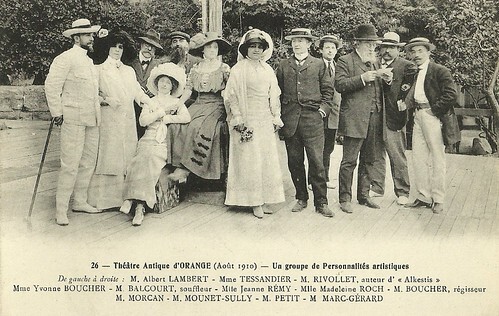
French postcard, no. 26. Caption: Théâtre Antique d'Orange, August 1910. The photo shows a group of artistic personalities, from left to right: Albert Lambert , Aimée Tessandier, Georges Rivollet (author of 'Alkestis', 1899), Yvonne Boucher, Balcourt (souffleur), Jeanne Rémy, Madeleine Roch, Boucher (director), Morcan, Jean Mounet-Sully , Petit, Marc Gérard. 'Alkestis' by Euripides was reworked by Rivollet. Albert Lambert had played the lead of Herakles in 'Alkestis' 1900 in Paris, while Paul Mounet , Mounet-Sully's elder brother had played the role at its premiere in 1899 at the Theatre d'Orange.
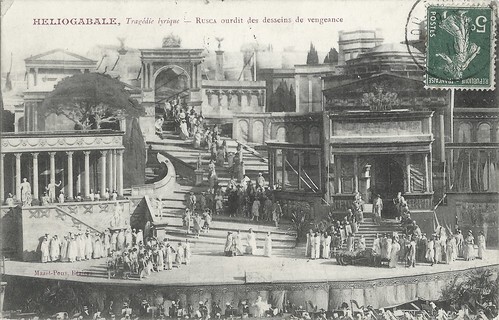
French postcard. Photo: Mazel-Pons, Béziers. Scene from the French open-air play 'Héliogabale', performed from 21 August 1910 at the Arènes de Béziers. Caption: Rusca ordait des desseins de vengeance (Rusca called for plans for revenge). 'Héliogabale' was a French lyric tragedy, with a ballet, three acts and a prologue. The libretto by Emile Sicard was based on the book 'L'agonie' by Jean Lombard. Music was by Déodat de Séverac. In addition to opera singers and ballet dancers from various opera houses, many actors of the Comédie-Française recited prose. Among them were Edouard de Max as the decadent and cruel Roman Emperor Heliogabalus, René Alexandre as the Christian Rusca, Jean Hervé as Claudien, and Madeleine Roch as Soemias, mother of Heliogabalus. The prestigious production drew a crowd of 15.000 and was generally positively reviewed, but the production costs were higher than the revenues, resulting in claims by various creditors, including the creators.
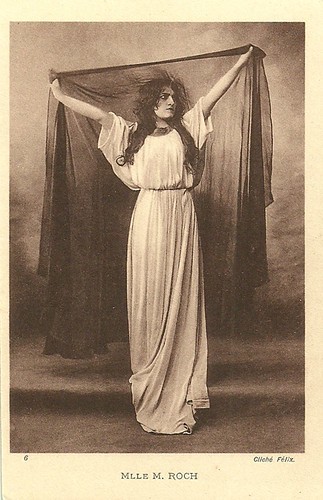
French postcard, no. 6. Photo: Félix. Madeleine Roch as the Tragic Muse in the play 'Les Cloches de Port Royal' at the Comedie Francaise in Paris. This picture was also used in the French magazine Le Theatre of March 1912.
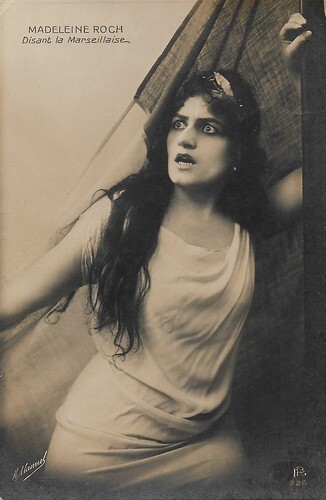
French postcard by P.R., no. 226. Photo: Henri Manuel. Madeleine Roch in perhaps the special war propaganda theatre show 'Three Guards Festival', performed in Paris on 28 April 1916. Roch performed 'La Marseillaise'. She co-acted with the actresses Vera Sergine and Carni Tub.
Source: Fondation Jerome Seydoux - Pathé, Wikipedia (French) and .

French postcard by F.C. & Cie, no. 498. Photo: Fémina.

Big photocard by Cinéma Pathé / Pathé Frères. Photo: S.A.P.F. Madeleine Roch as the title character in the historical drama Radgrune (Camille de Morlhon, 1911).

Big photo card by Cinéma Pathé / Pathé Frères. Photo: S.A.P.F. Madeleine Roch as the title character in the historical drama Radgrune (Camille de Morlhon, 1911). Right of her, René Alexandre as the young prince.
11 Film d'Art-like historical films
Julienne Madeleine Roch was born in 1883 in Les Mureaux, Yvelines, France. She entered the the Conservatoire national de musique et de déclamation in Paris in 1901 and attended the class of Silvani. She graduated the following year with a first prize for tragedy, playing the role of Roxane in Racine's 'Bajazet'. She entered the Comédie-Française in 1903 at the age of 20 and was Sociétaire (a member) between 1912 and 1930.
Between 1909 and 1911, Madeleine Roch acted in a series of 11 Film d'Art-like historical films. Most of these short silent films she made at Pathé Frères, but at Gaumont, she appeared in Esther (1910) by Louis Feuillade .
She made her film debut as Katusha, a country girl, who is seduced and abandoned by Prince Nekludov in the Lev Tolstoy adaptation Résurrection (André Calmettes, Henri Desfontaines, 1909). Henri Andréani directed her in Messaline (Ferdinand Zecca, Henri Andréani, 1910), Cléopâtre/Cleopatra (Ferdinand Zecca, Henri Andréani, 1910), and Moïse sauvé des eaux/Moses Saved from the Waters (Henri Andréani, 1911).
Camille de Morlhon directed her in Une intrigue à la cour d’Henry VIII/Anne Boleyn (Camille de Morlhon, 1911) and Radgrune (Camille de Morlhon, 1911). De Morlhon also scripted Radgrune. The plot deals with the rivalry between two powerful princes, Ildacre and Odobert (Louis Ravet). Odobert had a convoy headed for the neighbouring castle seized by an armed force. In revenge, Ildacre, at the instigation of his daughter Radgrune, abducts the son of Prince Odobert ( René Alexandre ). A dancer seduces the son and delivers him to Ildacre.
However, Radgrune falls in love with the prince whose death she wanted. She begs her father in vain to pardon her prisoner. Unable to bend his anger, she frees the young prince, having exchanged his clothes for hers. Left alone, the young girl, fearing her father's anger, prefers death and plunges a dagger into her heart, happy to sacrifice her life for the one she loves.

French postcard. Madeleine Roch was the nurse in the play 'Médée' by Catulle Mendès, performed at the Comédie Française, Paris in July 1903.

French postcard by F.C. & Cie, no. 247. Photo: Boyer and Bert. Madeleine Roch as Mme Hurtz in 'Paraître' by Maurice Donnay, performed in 1906.

French postcard. Photo by J. Maussier, Avignon. Caption: Madeleine Roch de la Comédie Française. Possibly in 'La fille du soleil'. Arènes de Béziers, 29 and 31 August 1909.
Sociétaire of the Comédie-Française
Madeleine Roch quit film acting in 1912, probably because she became Sociétaire of the Comédie-Française. She performed in particular the plays of Jean Racine, such as 'Bajazet', 'Bérénice', 'Andromaque', 'Brittanicus', 'Iphigénie' and 'Phèdre'.
She also acted in plays by Corneille and in Greek tragedies such as Sophocles' 'Electra' and Euripides's 'Iphigenia'. Sometimes, she did sidesteps in comedy, such as 'Paraître' (1906) by Maurice Donnay. She was also one of the great interpreters of Victor Hugo . In 1914, she was invited to Guernsey for the inauguration of a monument to Hugo, designed by Jean Boucher.
At the open air Théâtre des Arènes in Béziers, she starred in 'Le premier glaive' (1908), 'La fille du soleil' (1909), 'Héliogabale' (1910), and 'Les esclaves' (1910). She also performed in open air theatre at Orange, Cauterets and Pau.
Madeleine Roch died in 1930 in Gaillon-sur-Montcient at the age of 47. A street in her hometown Les Mureaux was named after her. There she is buried in the local cemetery. A commemorative plaque has been placed on the promenade des Marronniers, the former Théâtre de la Nature in Lectoure, where she performed for the last time on 3 August 1930.
Some of her films have survived. A black-and-white version of Moïse sauvé des eaux (Henri Andréani, 1911) can be found on YouTube. Roch plays Moses' mother. YouTube also offers a copy of the modern film Femme fatale (1912), in which Roch plays the mother of the first victim of the femme fatale. Un intrigue à la cour d'Henri VIII is also on YouTube in a in-coloured version. Roch plays Jane Seymour, who plots the downfall of her rival, Queen Anne Boleyn, played by Léontine Massart. The title on the English titled print is also: Anne Boleyn.

French postcard, no. 26. Caption: Théâtre Antique d'Orange, August 1910. The photo shows a group of artistic personalities, from left to right: Albert Lambert , Aimée Tessandier, Georges Rivollet (author of 'Alkestis', 1899), Yvonne Boucher, Balcourt (souffleur), Jeanne Rémy, Madeleine Roch, Boucher (director), Morcan, Jean Mounet-Sully , Petit, Marc Gérard. 'Alkestis' by Euripides was reworked by Rivollet. Albert Lambert had played the lead of Herakles in 'Alkestis' 1900 in Paris, while Paul Mounet , Mounet-Sully's elder brother had played the role at its premiere in 1899 at the Theatre d'Orange.

French postcard. Photo: Mazel-Pons, Béziers. Scene from the French open-air play 'Héliogabale', performed from 21 August 1910 at the Arènes de Béziers. Caption: Rusca ordait des desseins de vengeance (Rusca called for plans for revenge). 'Héliogabale' was a French lyric tragedy, with a ballet, three acts and a prologue. The libretto by Emile Sicard was based on the book 'L'agonie' by Jean Lombard. Music was by Déodat de Séverac. In addition to opera singers and ballet dancers from various opera houses, many actors of the Comédie-Française recited prose. Among them were Edouard de Max as the decadent and cruel Roman Emperor Heliogabalus, René Alexandre as the Christian Rusca, Jean Hervé as Claudien, and Madeleine Roch as Soemias, mother of Heliogabalus. The prestigious production drew a crowd of 15.000 and was generally positively reviewed, but the production costs were higher than the revenues, resulting in claims by various creditors, including the creators.

French postcard, no. 6. Photo: Félix. Madeleine Roch as the Tragic Muse in the play 'Les Cloches de Port Royal' at the Comedie Francaise in Paris. This picture was also used in the French magazine Le Theatre of March 1912.

French postcard by P.R., no. 226. Photo: Henri Manuel. Madeleine Roch in perhaps the special war propaganda theatre show 'Three Guards Festival', performed in Paris on 28 April 1916. Roch performed 'La Marseillaise'. She co-acted with the actresses Vera Sergine and Carni Tub.
Source: Fondation Jerome Seydoux - Pathé, Wikipedia (French) and .
Published on October 23, 2024 22:00
October 22, 2024
Ross Verlag, Part 7: How Ross Expanded
Around 1930, Ross seemed to be everywhere. Not only in Germany but also in many other European countries, film fans bought Ross star postcards to send them to their friends and their family or to collect them in an album. Ross started to produce postcards in Great Britain (Ross Verlag Foreign) and in France (Edition Ross). Film fans could collect all kinds of Ross cards, very small cigarette cards but also big cards in a XXL format. You also could find Ross cards in the magazine Das Programm von Heute. For this post, we selected 25 of our favourite Ross curiosities. In the next months, EFSP will continue this weekly Ross Verlag Tribute with posts on which we will focus on the series of these special postcards, cigarette cards or other collector cards.
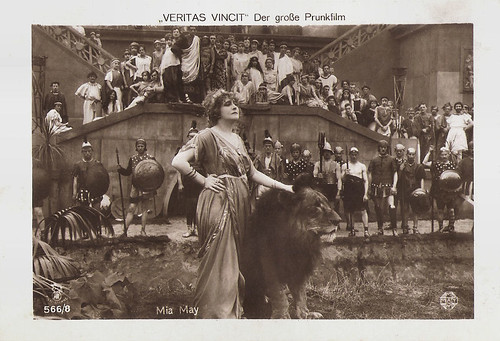
German postcard by Rotophot in the Film Sterne series, no. 566/8. Photo: May Film. Mia May in the first part of Veritas vincit (Joe May, 1919). Before he founded Ross Verlag in 1919, Heinrich Ross worked for Rotophot and its Film Sterne series . In fact, Film Sterne and Ross Verlag were part of the same series of cards, so the Ross Verlag numbering continued on from where Film Sterne ended. What can make it difficult to follow is that the portrait and film scene cards were seen as two separate series in the beginning. The Film Sterne film scene cards began at #500 and continued on until #568, and then the Ross Verlag name took on from there with the film scene cards until #700.
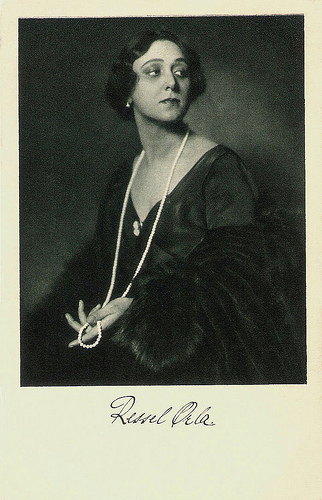
Ressel Orla . German postcard by Verlag W.J. Mörlins / Ross Verlag, Berlin, no. 9010/3. Photo: Karl Schenker. W.J. Mörlins was a German publishing company located in Berlin which operated in the early 1920s. Mörlins published autobiographies of the actors Bruno Kastner ('Von mir über mir', 1921) and Hella Moja ('Nie wieder in meinem Leben!', 1921), as well as deluxe albums of the four-part film Fridericus Rex (1921-1922). Mörlins also published four film star postcards series which were distributed by Ross Verlag. Remarkable is that master photographer Karl Schenker took all the pictures for the Mörlins cards.
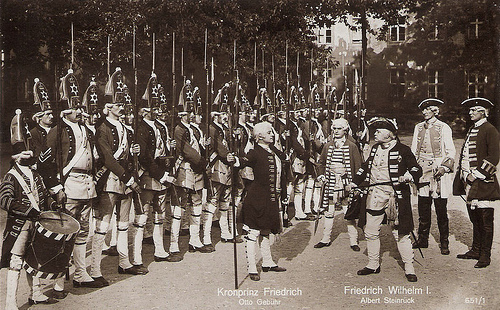
German postcard by W. Mörlins / Ross Verlag, no. 651/1. Photo: Karl Schenker. Otto Gebühr as crown prince Friedrich (Frederick, the future Frederick the Great), and Albert Steinrück as his father Friedrich Wilhelm I in the Fridericus Rex trilogy (Arzén von Cserépy, 1922-1923).
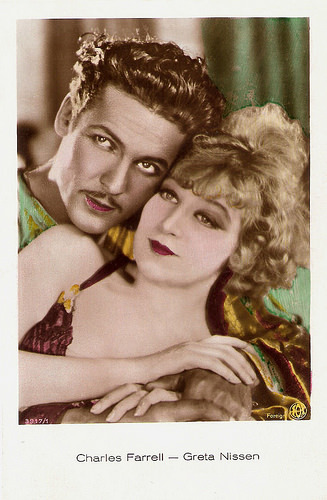
Greta Nissen and Charles Farrell . British postcard by Ross Verlag, no. 3917/1, 1928-1929. Photo: Fox. Publicity still for Fazil (Howard Hawks, 1928).
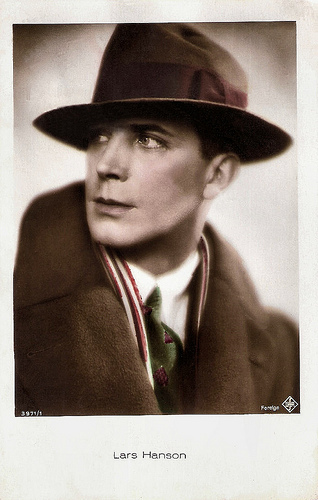
British Foreign postcard by Ross Verlag, no. 3971/1, 1928-1929. Photo: Ufa. Lars Hanson .
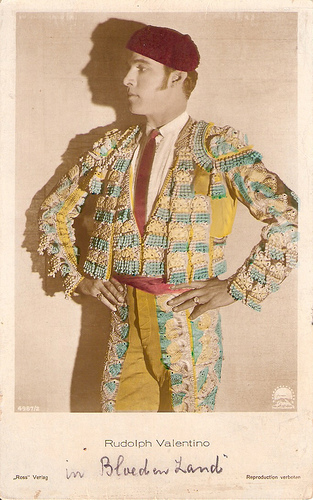
German postcard by Ross Verlag in colour, no. 4987/2, 1929-1930. Photo: Paramount. Rudolph Valentino in Blood and Sand (Fred Niblo, 1922).
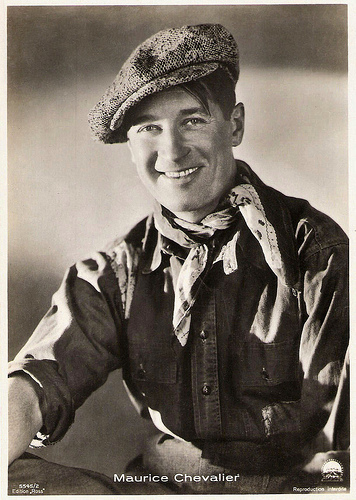
French postcard by Edition Ross, no. 5545/2. Photo: Paramount. Maurice Chevalier appeared as Apache in three acts of Paramount on Parade (1930), filmed by numerous directors including Ernst Lubitsch.
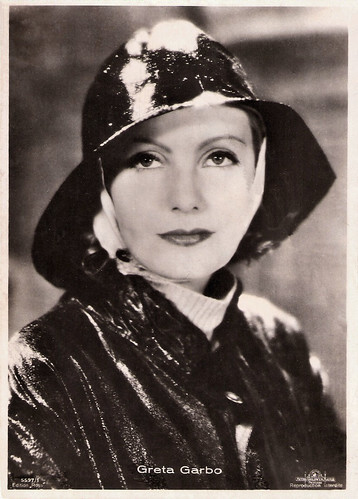
French postcard by Edition Ross, no. 5597/1, 1930-1931. Photo: Metro-Goldwyn-Mayer. Greta Garbo in Anna Christie (Clarence Brown, 1930).
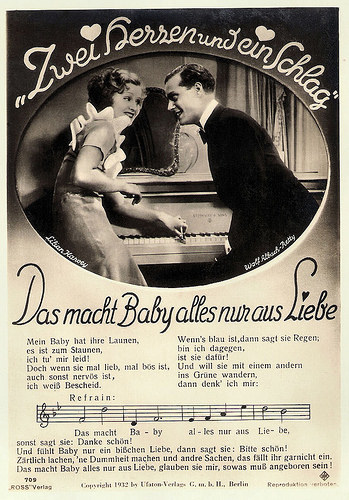
German postcard by Ross Verlag, no. 709. Photo: Ufa. Lilian Harvey and Wolf Albach-Retty in Zwei Herzen und ein Schlag/Two Hearts Beat as One (Wilhelm Thiele, 1932). Collection: Geoffrey Donaldson Institute. Both in Germany and France, many postcards quoted the songs of early film musicals. These were very important for the establishment of the new sound cinema.
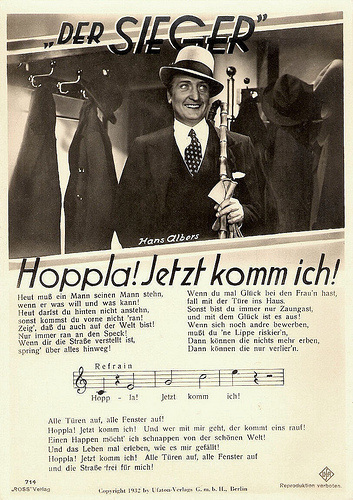
German postcard by Ross Verlag, no. 714, 1932. Photo: Ufa. 'Hoppla! Jetzt komm ich' was a song from the comedy film Der Sieger/The Winner (Hans Hinrich, Paul Martin, 1932) with Hans Albers .
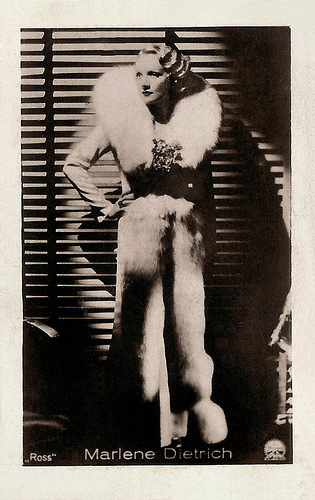
German collectors card by Ross Verlag. Photo: Paramount. Marlene Dietrich .
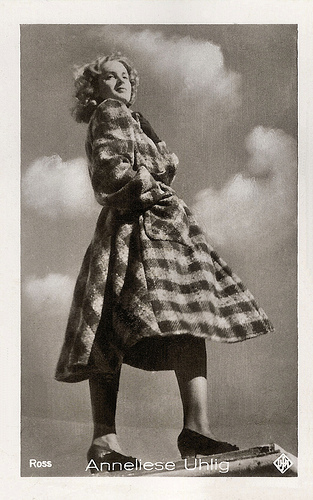
Small German collectors card by Ross. Photo: Ufa. Anneliese Uhlig .
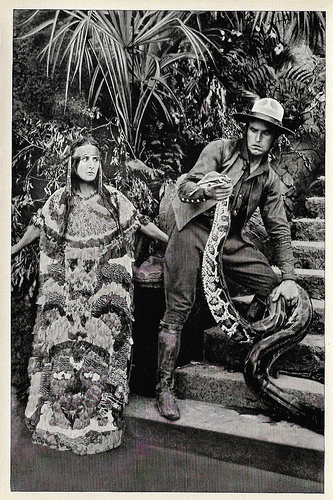
German collectors card by Ross Verlag for the album Vom Werden deutscher Filmkunst. Teil I. Der stumme Film (Cigaretten-Bilderdienst Altona-Bahrenfeld 1935). Lil Dagover and Carl de Vogt in Die Spinnen/The Spiders (Fritz Lang, 1919).
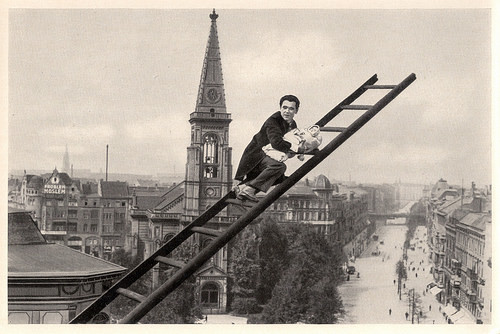
German collectors card by Ross Verlag for the album Vom Werden deutscher Filmkunst. Teil I. Der stumme Film (Cigaretten-Bilderdienst Altona-Bahrenfeld 1935). Luciano Albertini in Der Mann auf dem Kometen (Alfred Halm, 1925). The silent film was set in Berlin. This image combines two moments in the film. Towards the end of the film, Luciano uses a ladder to save a baby put on an old factory chimney pipe which is about to explode. The church is a typical example of Wilhelminian architecture, the site may be somewhere in the old Stadmitte of Berlin where most Albertini films were shot when filmed in Berlin. Problem Moslem refers to a cigarette brand.
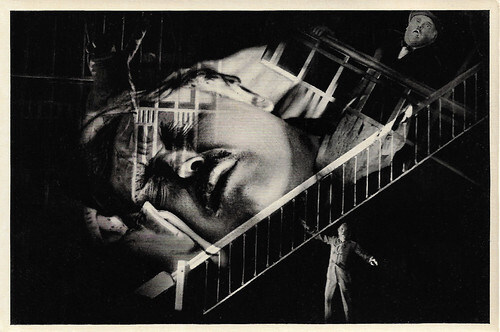
German collectors card by Ross Verlag for the album Vom Werden deutscher Filmkunst. Teil I. Der stumme Film (Cigaretten-Bilderdienst Altona-Bahrenfeld 1935). Photo: Ufa. Werner Krauss in the classic German film Geheimnisse einer Seele (G.W. Pabst, 1926).
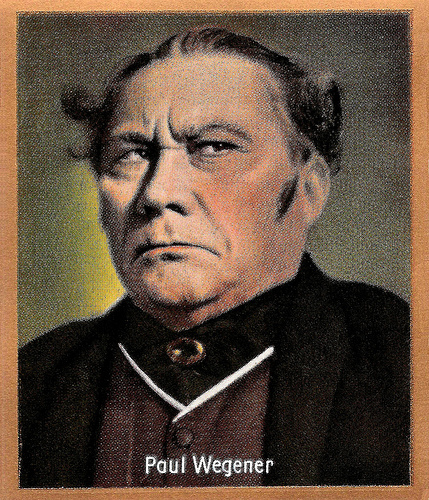
German cigarette card in the series Unsere Bunten Filmbilder by Ross Verlag for Cigarettenfabrik Josetti, Berlin, no. 193. Photo: Lilenberger. Paul Wegener .
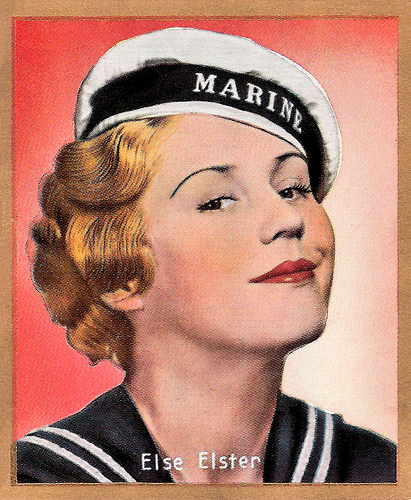
German cigarette card in the series Unsere Bunten Filmbilder by Ross Verlag for Cigarettenfabrik Josetti, Berlin, no. 153. Photo: Alex Binder. Else Elster .
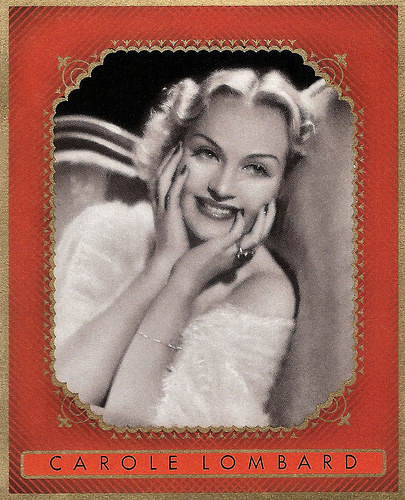
German collectors card in the Bunte Filmbilder series by Greilingen-Zigaretten, Series no. 2, no. 259. Photo: Paramount / Ross-Verlag. Carole Lombard .
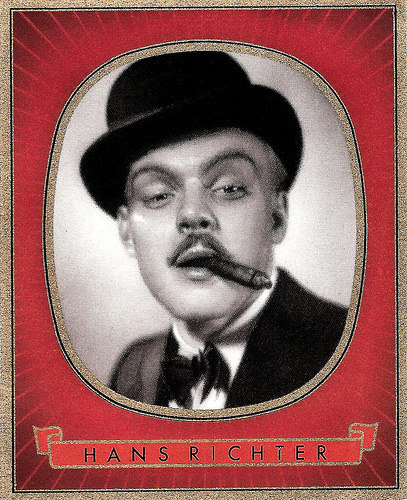
German collectors card in the Bunte Filmbilder series by Drama Zigaretten, Series no. 2, no. 459. Photo: Cando-Film / Ross-Verlag. Hans Richter .
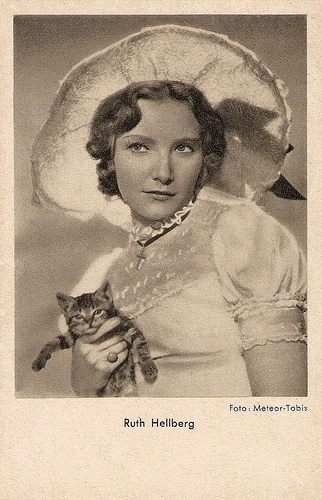
German postcard by Das Programm von Heute / Ross Verlag. Photo: Meteor / Tobis. Ruth Hellberg and kitten.
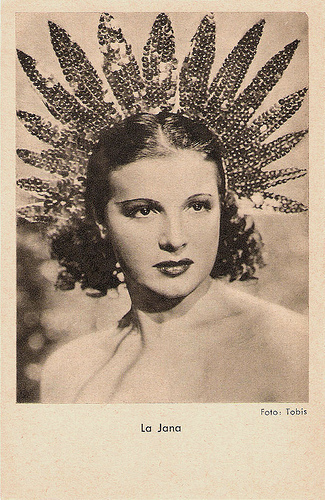
German postcard by Das Programm von Heute / Ross Verlag. Photo: Tobis. La Jana .
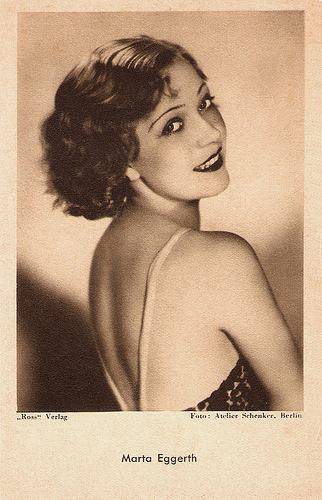
German postcard by Das Programm von Heute / Ross Verlag. Photo: Atelier Schenker, Berlin. Marta Eggerth.
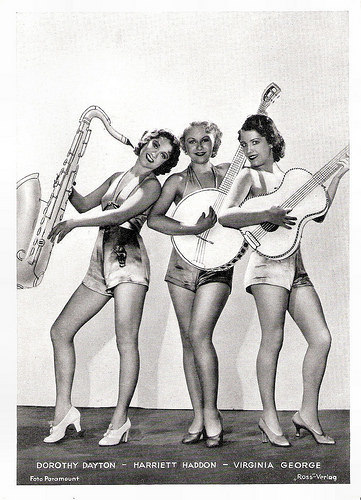
Big German card by Ross Verlag. Photo: Paramount. From left to right the American chorus girls Dorothy Dayton, Harriett Haddon and Virginia George. They all appeared - uncredited - in College Rhythm (Norman Taurog, 1934).
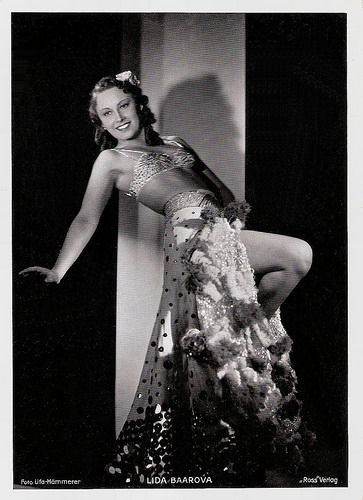
Big German postcard by Ross Verlag. Photo: Ufa / Hämmerer. Lida Baarova .
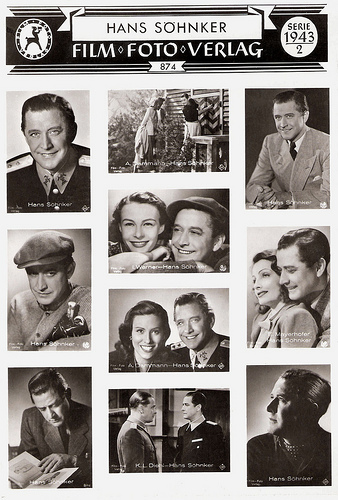
German presentation card by Film-Foto-Verlag, no. 874, series 1943/2. Hans Söhnker .
With thanks to Jean Ritsema and Ivo Blom! Our Ross Verlag Tribute will be continued next week and please, remember to check out the Ross Verlag Movie Stars Postcards website.

German postcard by Rotophot in the Film Sterne series, no. 566/8. Photo: May Film. Mia May in the first part of Veritas vincit (Joe May, 1919). Before he founded Ross Verlag in 1919, Heinrich Ross worked for Rotophot and its Film Sterne series . In fact, Film Sterne and Ross Verlag were part of the same series of cards, so the Ross Verlag numbering continued on from where Film Sterne ended. What can make it difficult to follow is that the portrait and film scene cards were seen as two separate series in the beginning. The Film Sterne film scene cards began at #500 and continued on until #568, and then the Ross Verlag name took on from there with the film scene cards until #700.

Ressel Orla . German postcard by Verlag W.J. Mörlins / Ross Verlag, Berlin, no. 9010/3. Photo: Karl Schenker. W.J. Mörlins was a German publishing company located in Berlin which operated in the early 1920s. Mörlins published autobiographies of the actors Bruno Kastner ('Von mir über mir', 1921) and Hella Moja ('Nie wieder in meinem Leben!', 1921), as well as deluxe albums of the four-part film Fridericus Rex (1921-1922). Mörlins also published four film star postcards series which were distributed by Ross Verlag. Remarkable is that master photographer Karl Schenker took all the pictures for the Mörlins cards.

German postcard by W. Mörlins / Ross Verlag, no. 651/1. Photo: Karl Schenker. Otto Gebühr as crown prince Friedrich (Frederick, the future Frederick the Great), and Albert Steinrück as his father Friedrich Wilhelm I in the Fridericus Rex trilogy (Arzén von Cserépy, 1922-1923).

Greta Nissen and Charles Farrell . British postcard by Ross Verlag, no. 3917/1, 1928-1929. Photo: Fox. Publicity still for Fazil (Howard Hawks, 1928).

British Foreign postcard by Ross Verlag, no. 3971/1, 1928-1929. Photo: Ufa. Lars Hanson .

German postcard by Ross Verlag in colour, no. 4987/2, 1929-1930. Photo: Paramount. Rudolph Valentino in Blood and Sand (Fred Niblo, 1922).

French postcard by Edition Ross, no. 5545/2. Photo: Paramount. Maurice Chevalier appeared as Apache in three acts of Paramount on Parade (1930), filmed by numerous directors including Ernst Lubitsch.

French postcard by Edition Ross, no. 5597/1, 1930-1931. Photo: Metro-Goldwyn-Mayer. Greta Garbo in Anna Christie (Clarence Brown, 1930).

German postcard by Ross Verlag, no. 709. Photo: Ufa. Lilian Harvey and Wolf Albach-Retty in Zwei Herzen und ein Schlag/Two Hearts Beat as One (Wilhelm Thiele, 1932). Collection: Geoffrey Donaldson Institute. Both in Germany and France, many postcards quoted the songs of early film musicals. These were very important for the establishment of the new sound cinema.

German postcard by Ross Verlag, no. 714, 1932. Photo: Ufa. 'Hoppla! Jetzt komm ich' was a song from the comedy film Der Sieger/The Winner (Hans Hinrich, Paul Martin, 1932) with Hans Albers .

German collectors card by Ross Verlag. Photo: Paramount. Marlene Dietrich .

Small German collectors card by Ross. Photo: Ufa. Anneliese Uhlig .

German collectors card by Ross Verlag for the album Vom Werden deutscher Filmkunst. Teil I. Der stumme Film (Cigaretten-Bilderdienst Altona-Bahrenfeld 1935). Lil Dagover and Carl de Vogt in Die Spinnen/The Spiders (Fritz Lang, 1919).

German collectors card by Ross Verlag for the album Vom Werden deutscher Filmkunst. Teil I. Der stumme Film (Cigaretten-Bilderdienst Altona-Bahrenfeld 1935). Luciano Albertini in Der Mann auf dem Kometen (Alfred Halm, 1925). The silent film was set in Berlin. This image combines two moments in the film. Towards the end of the film, Luciano uses a ladder to save a baby put on an old factory chimney pipe which is about to explode. The church is a typical example of Wilhelminian architecture, the site may be somewhere in the old Stadmitte of Berlin where most Albertini films were shot when filmed in Berlin. Problem Moslem refers to a cigarette brand.

German collectors card by Ross Verlag for the album Vom Werden deutscher Filmkunst. Teil I. Der stumme Film (Cigaretten-Bilderdienst Altona-Bahrenfeld 1935). Photo: Ufa. Werner Krauss in the classic German film Geheimnisse einer Seele (G.W. Pabst, 1926).

German cigarette card in the series Unsere Bunten Filmbilder by Ross Verlag for Cigarettenfabrik Josetti, Berlin, no. 193. Photo: Lilenberger. Paul Wegener .

German cigarette card in the series Unsere Bunten Filmbilder by Ross Verlag for Cigarettenfabrik Josetti, Berlin, no. 153. Photo: Alex Binder. Else Elster .

German collectors card in the Bunte Filmbilder series by Greilingen-Zigaretten, Series no. 2, no. 259. Photo: Paramount / Ross-Verlag. Carole Lombard .

German collectors card in the Bunte Filmbilder series by Drama Zigaretten, Series no. 2, no. 459. Photo: Cando-Film / Ross-Verlag. Hans Richter .

German postcard by Das Programm von Heute / Ross Verlag. Photo: Meteor / Tobis. Ruth Hellberg and kitten.

German postcard by Das Programm von Heute / Ross Verlag. Photo: Tobis. La Jana .

German postcard by Das Programm von Heute / Ross Verlag. Photo: Atelier Schenker, Berlin. Marta Eggerth.

Big German card by Ross Verlag. Photo: Paramount. From left to right the American chorus girls Dorothy Dayton, Harriett Haddon and Virginia George. They all appeared - uncredited - in College Rhythm (Norman Taurog, 1934).

Big German postcard by Ross Verlag. Photo: Ufa / Hämmerer. Lida Baarova .

German presentation card by Film-Foto-Verlag, no. 874, series 1943/2. Hans Söhnker .
With thanks to Jean Ritsema and Ivo Blom! Our Ross Verlag Tribute will be continued next week and please, remember to check out the Ross Verlag Movie Stars Postcards website.
Published on October 22, 2024 22:00
Paul van Yperen's Blog
- Paul van Yperen's profile
- 13 followers
Paul van Yperen isn't a Goodreads Author
(yet),
but they
do have a blog,
so here are some recent posts imported from
their feed.



